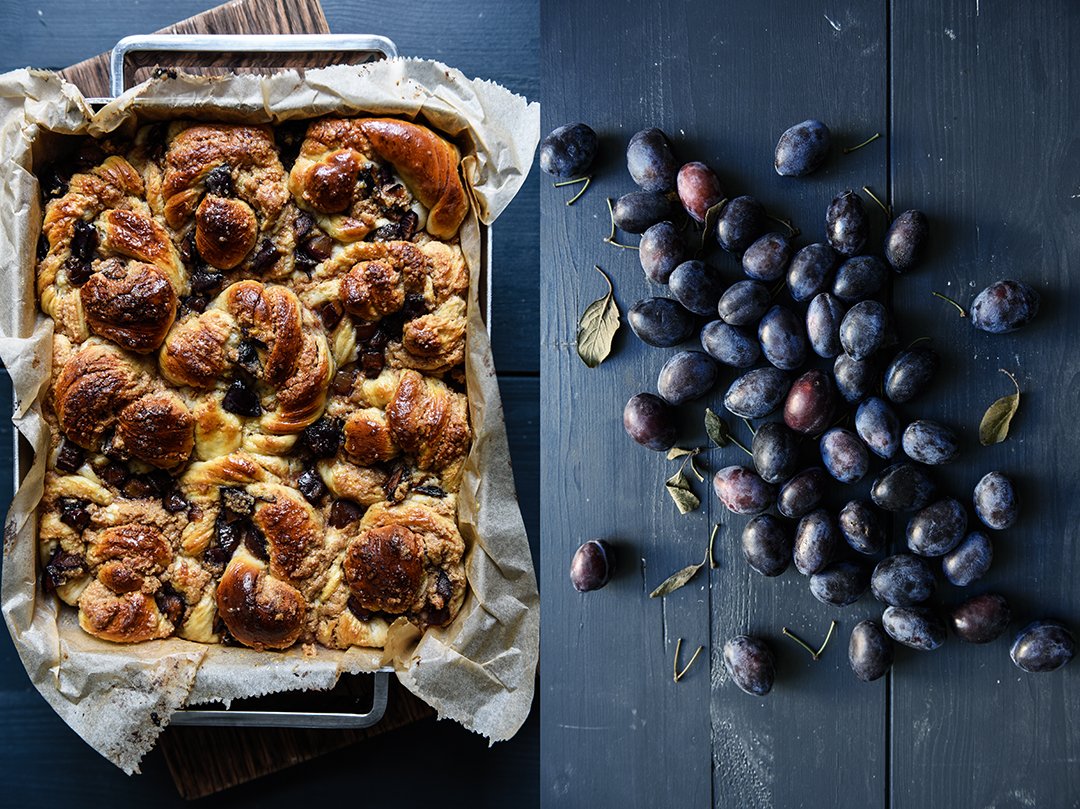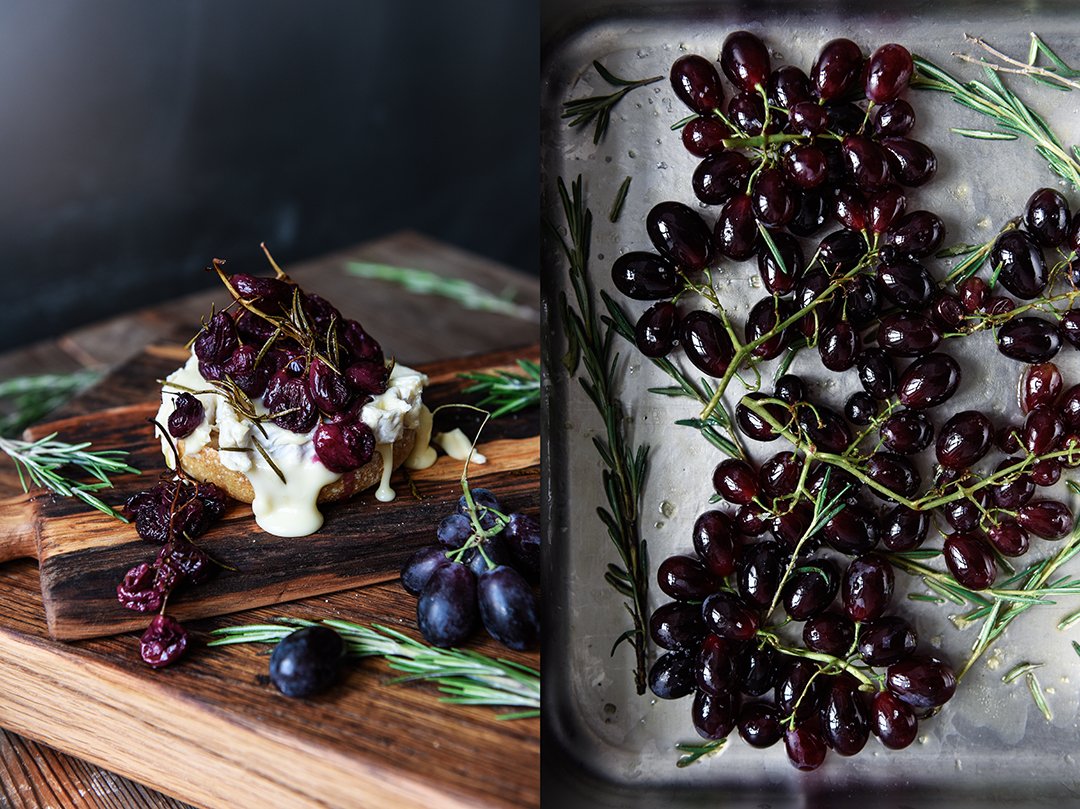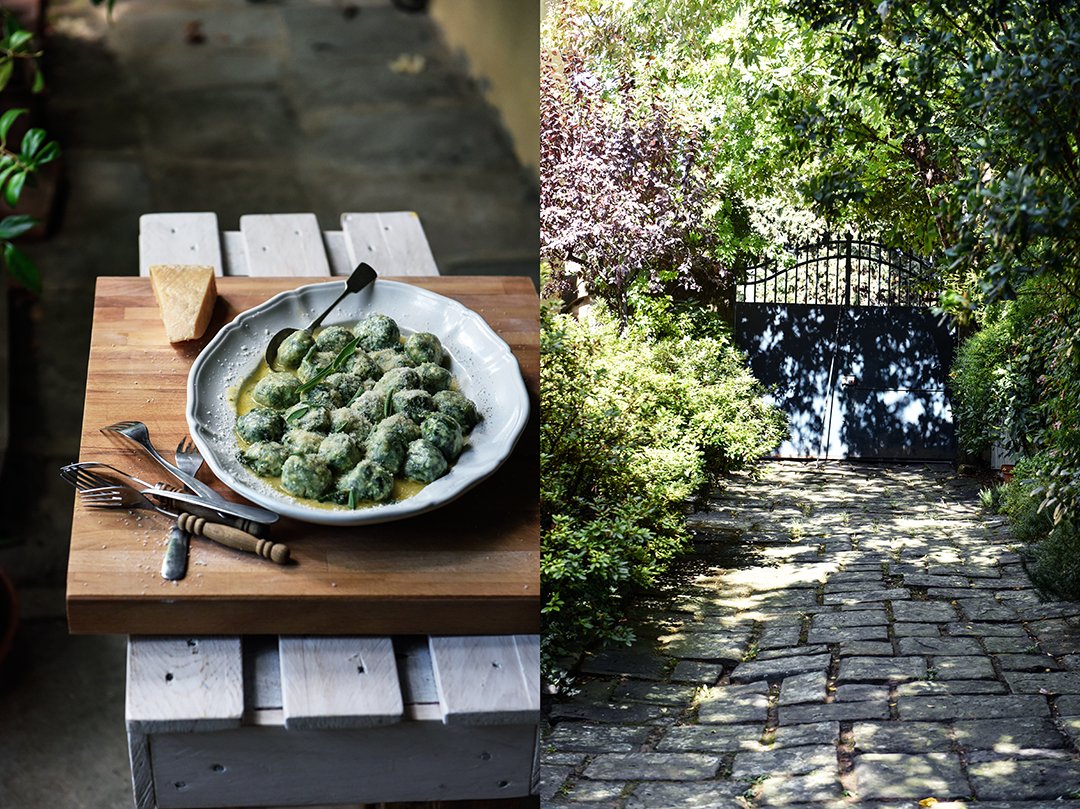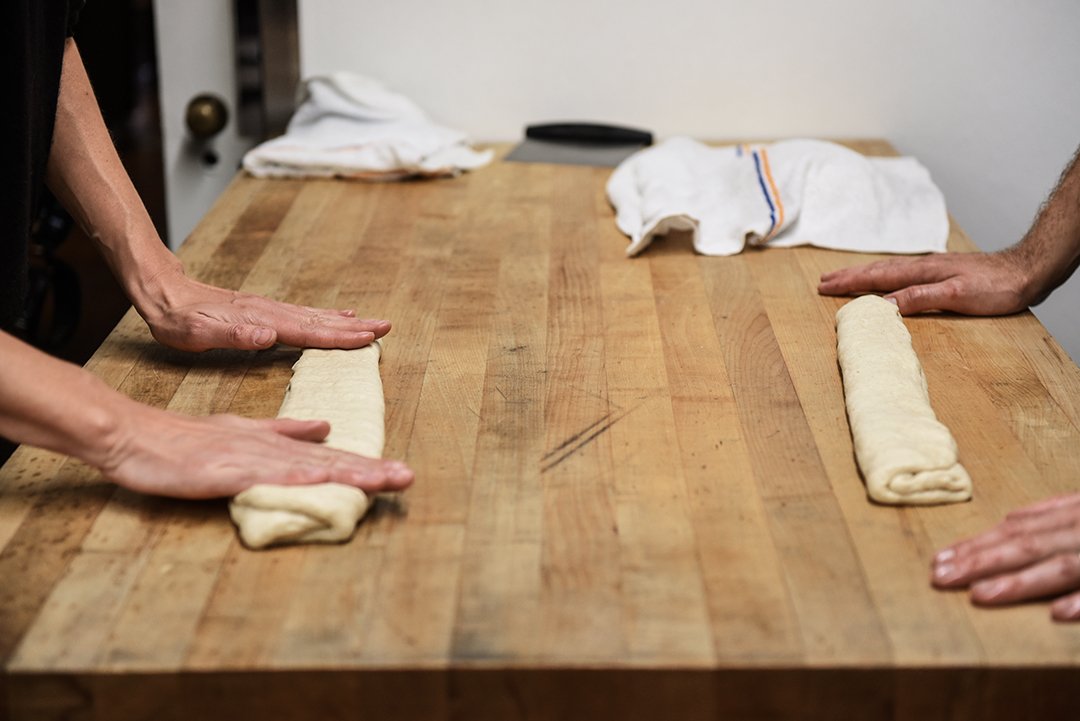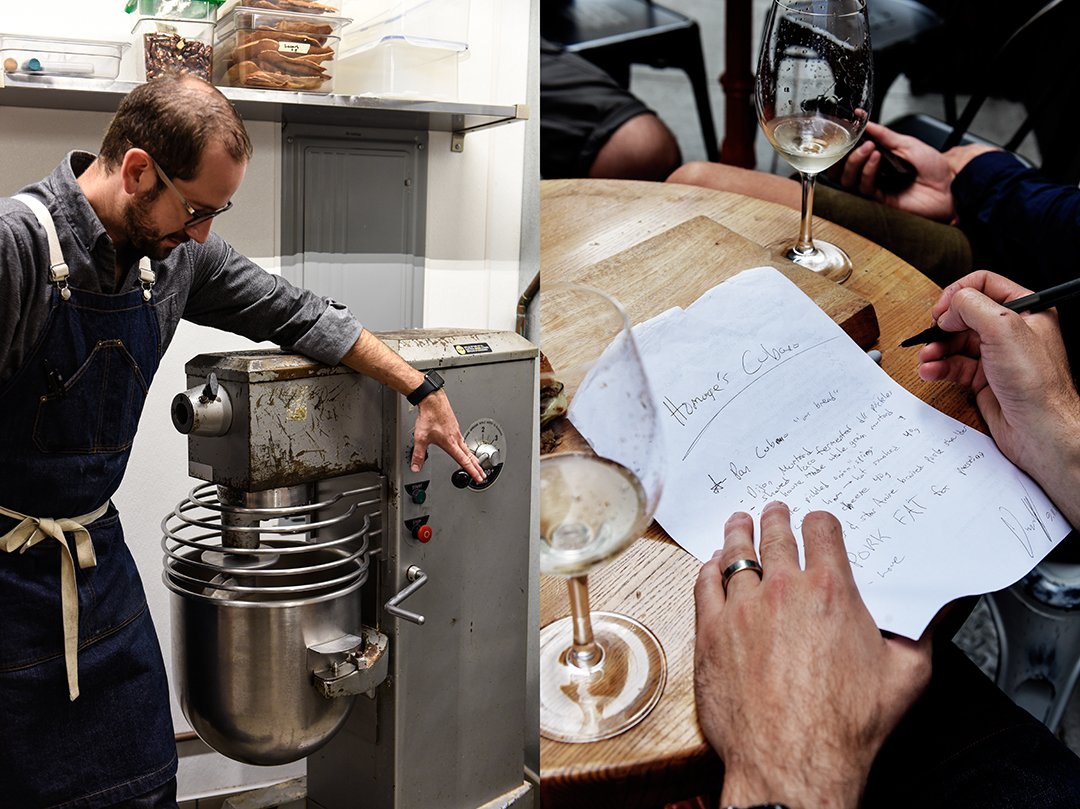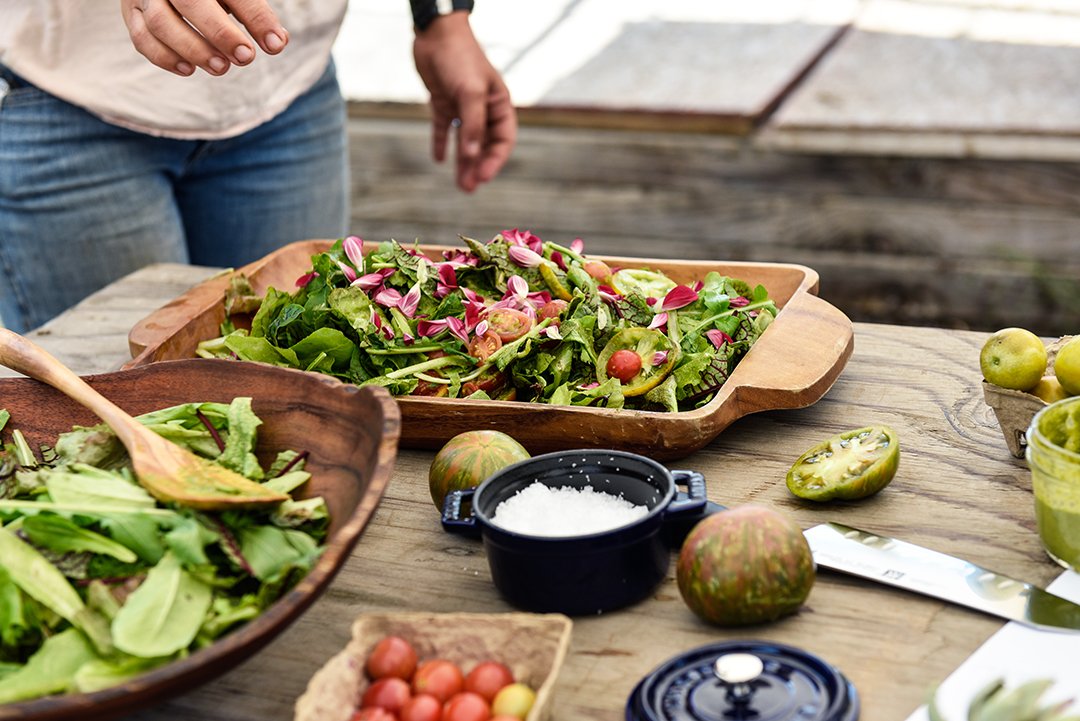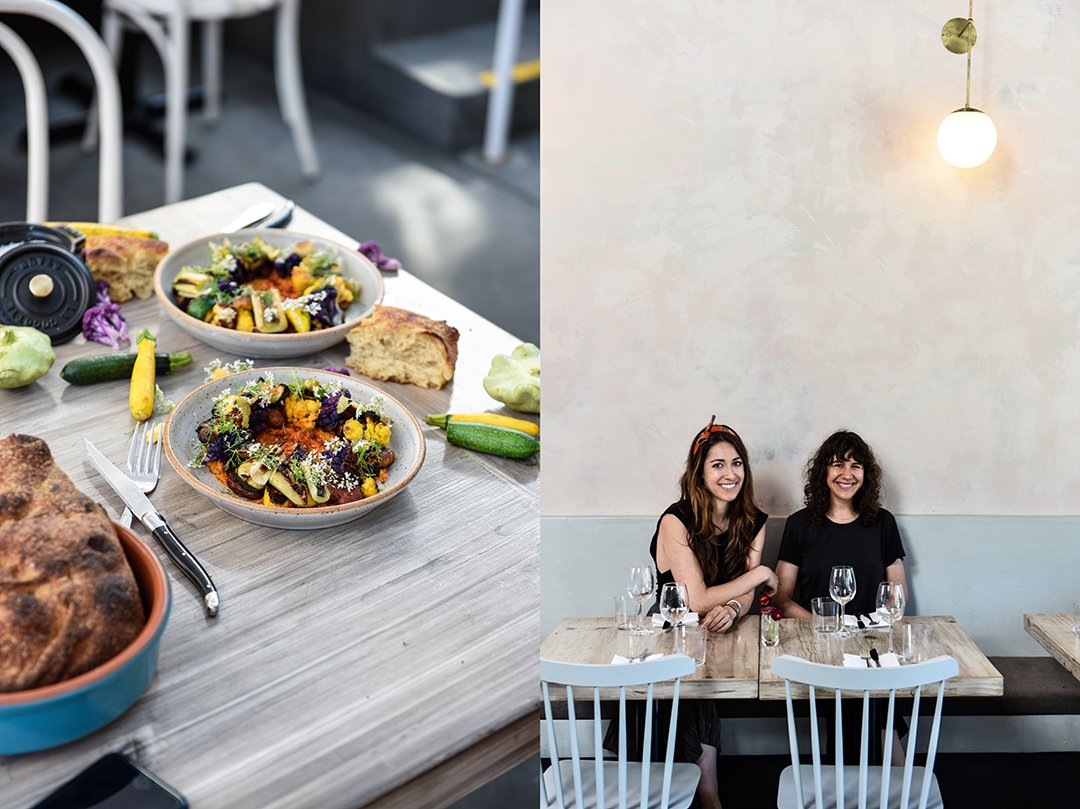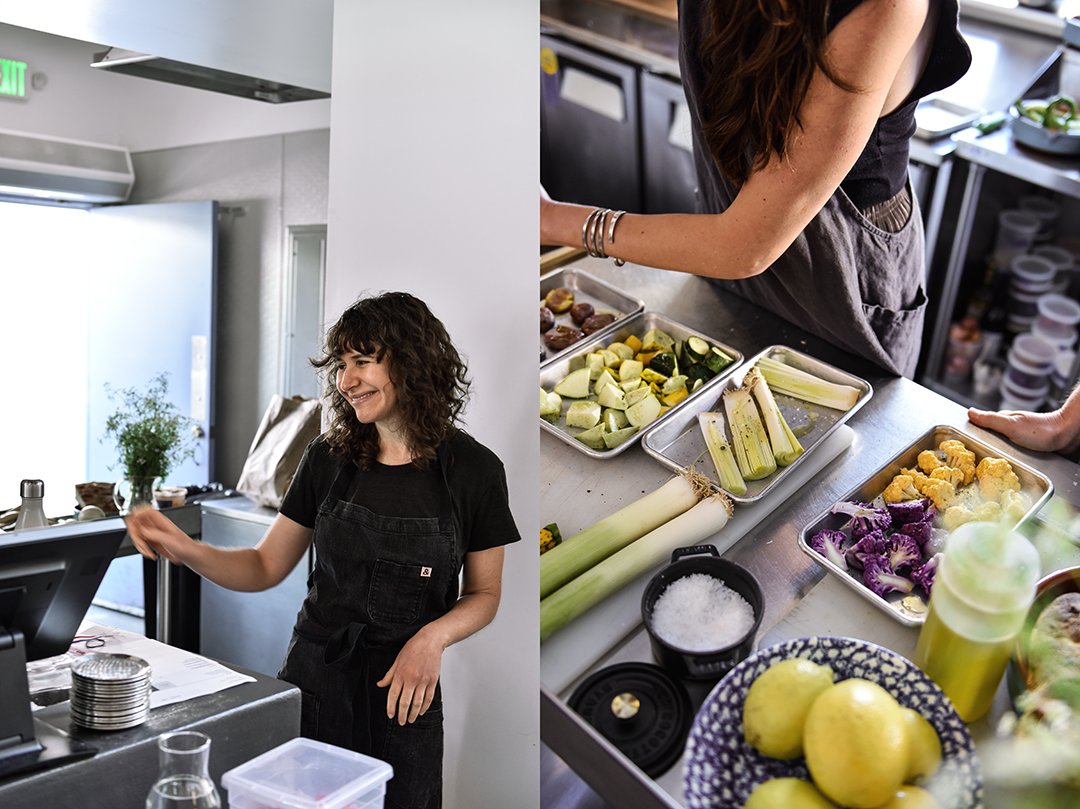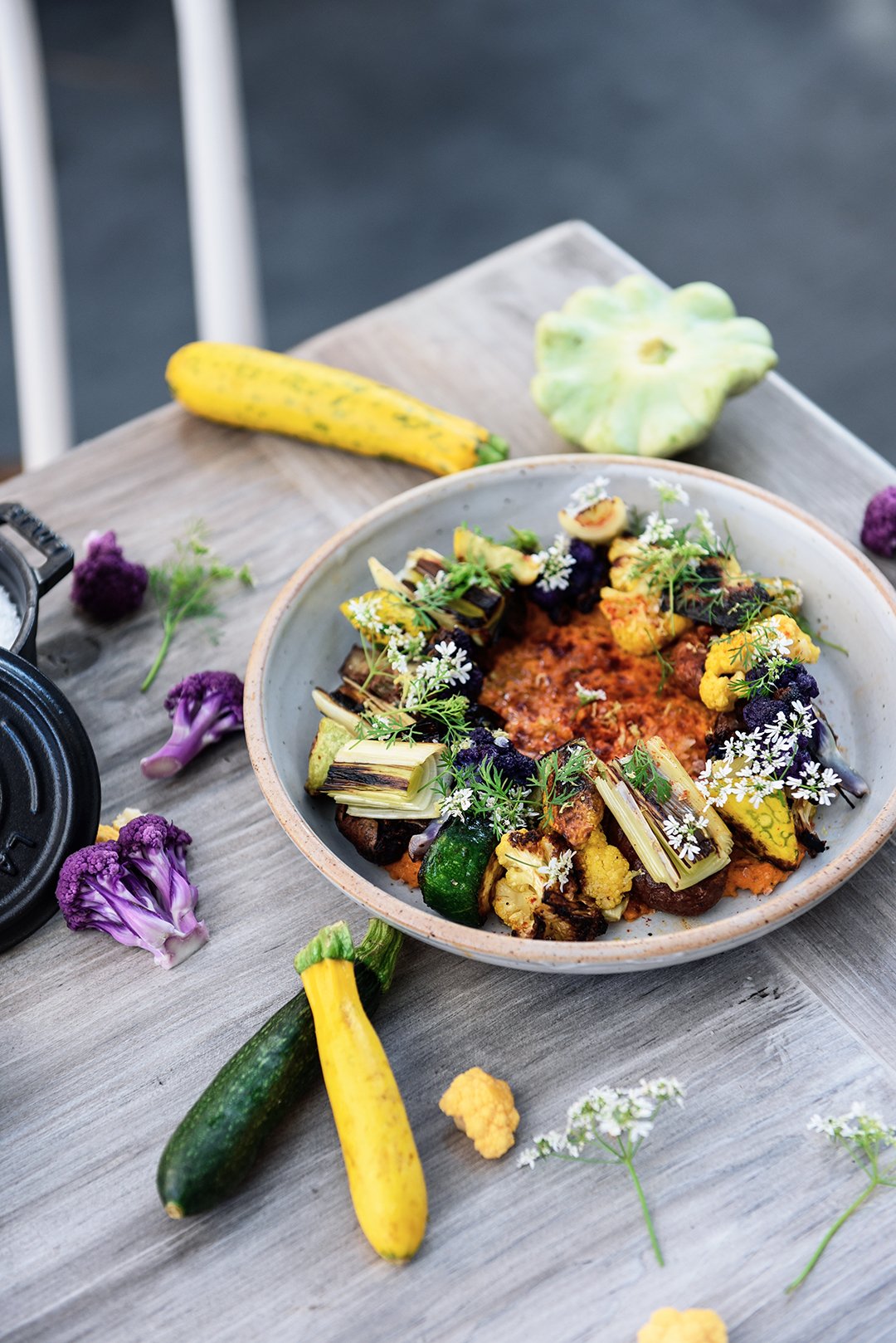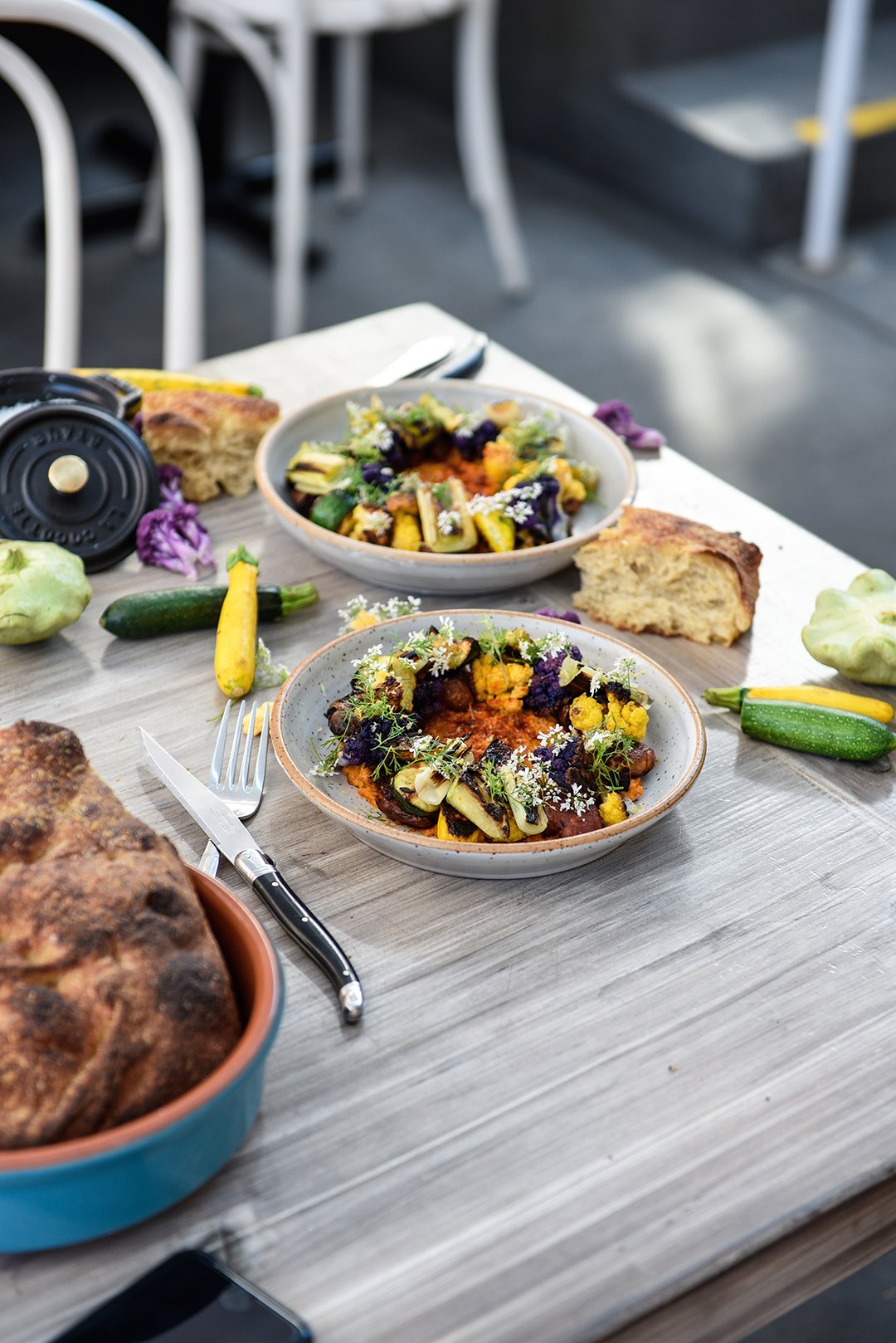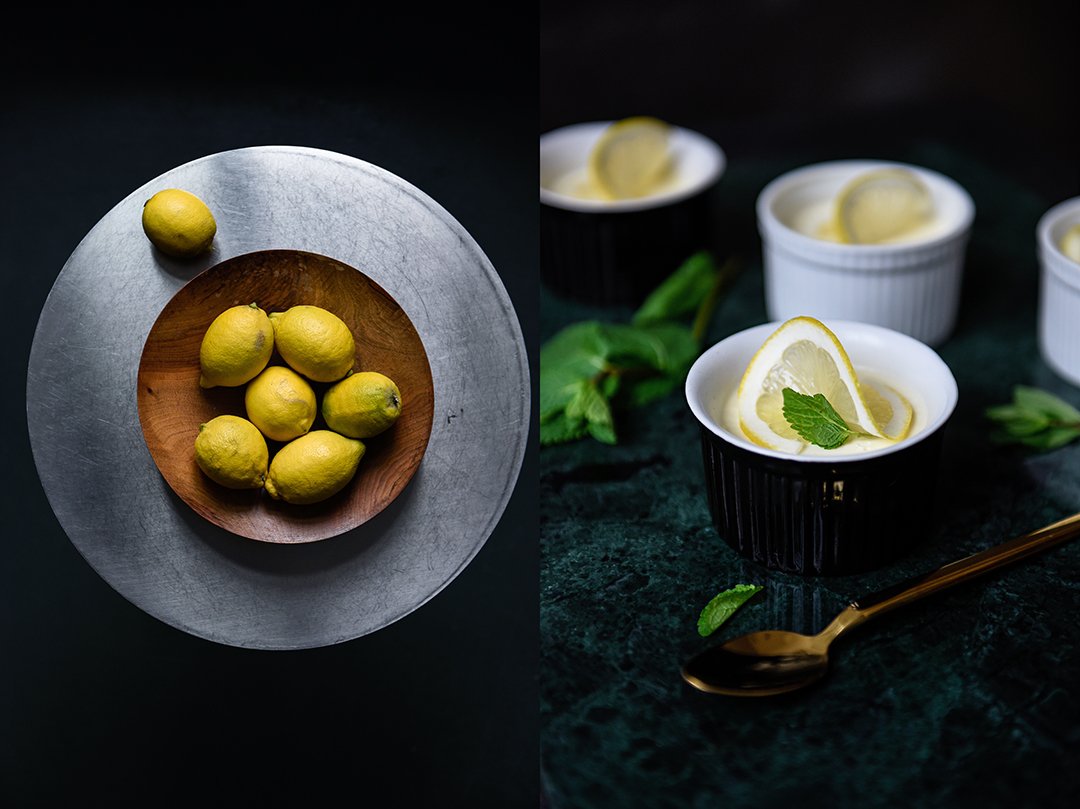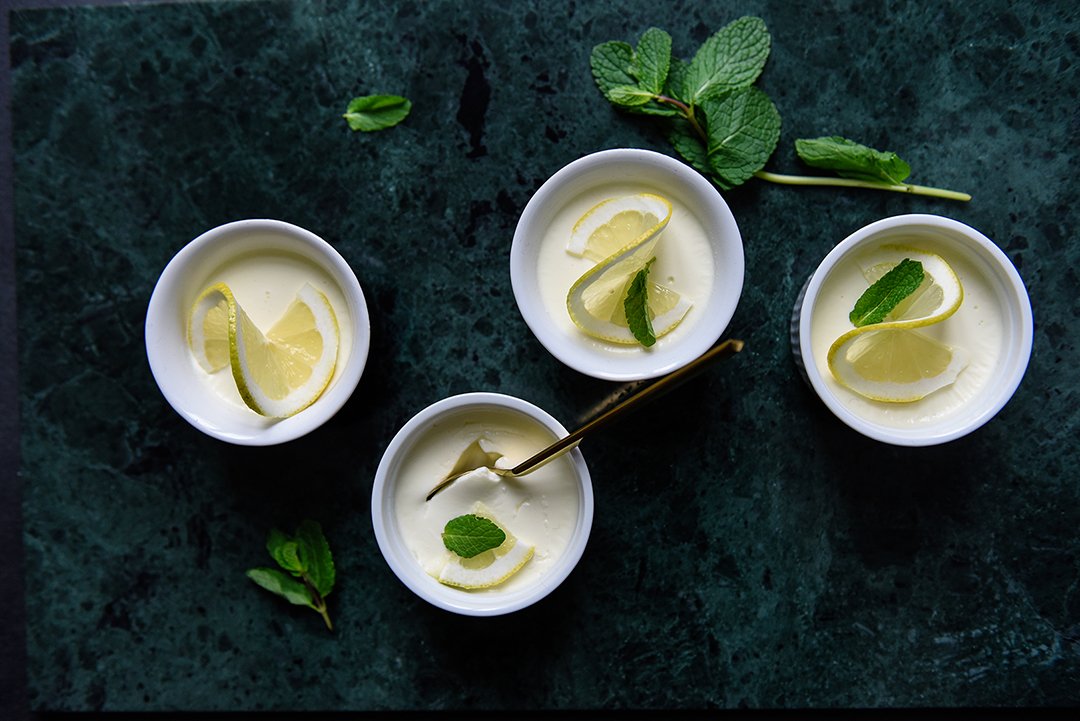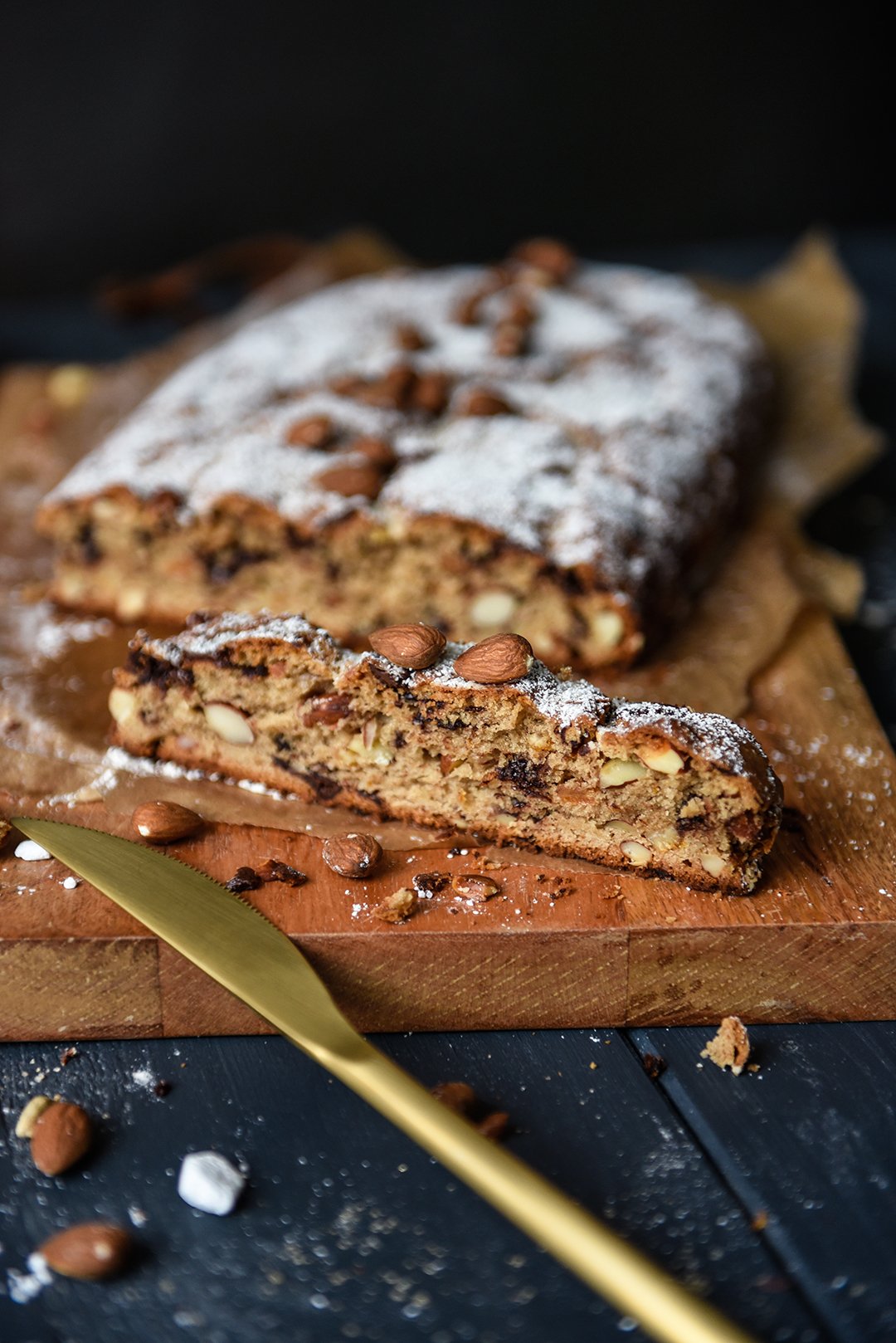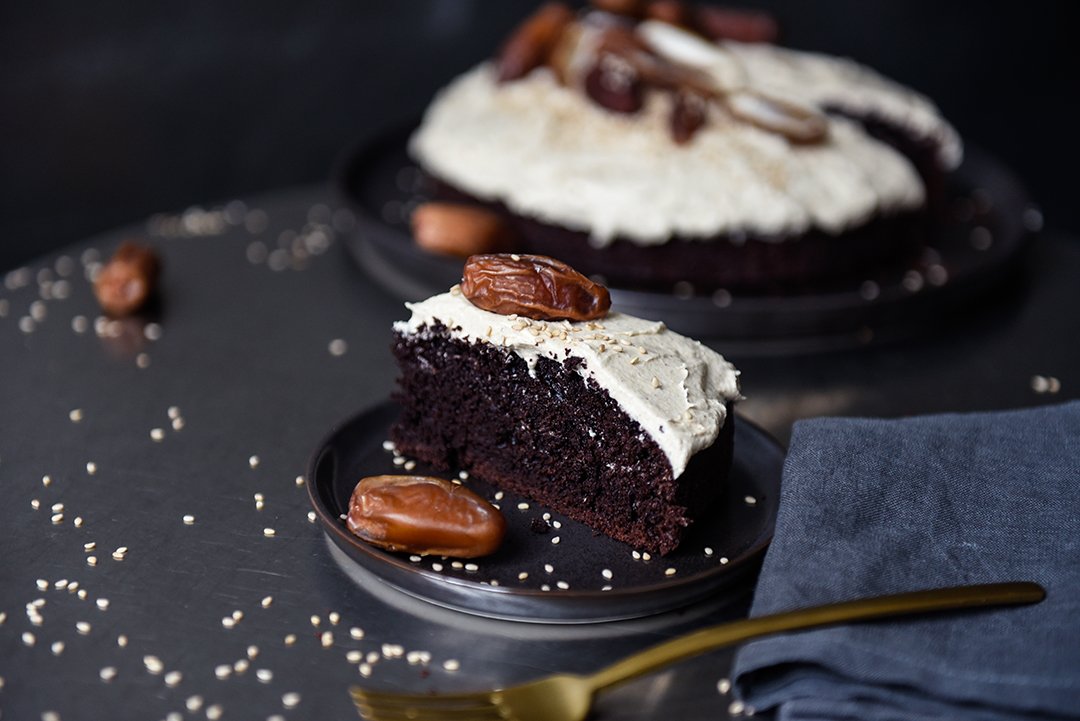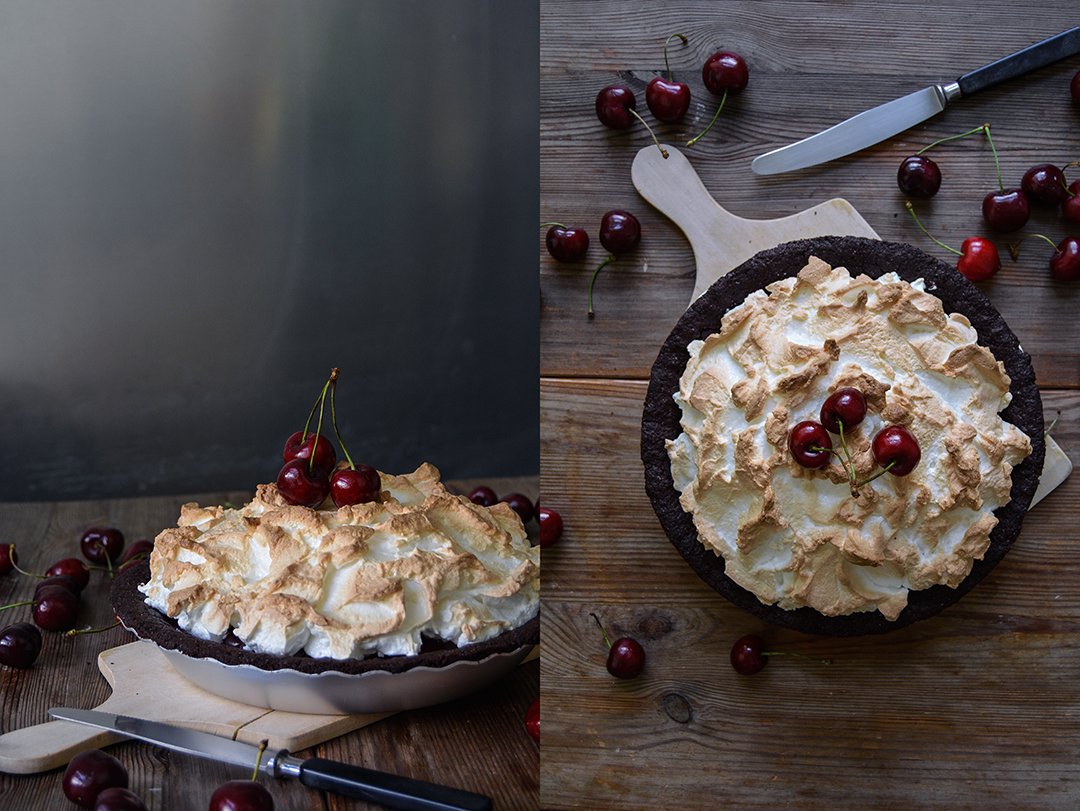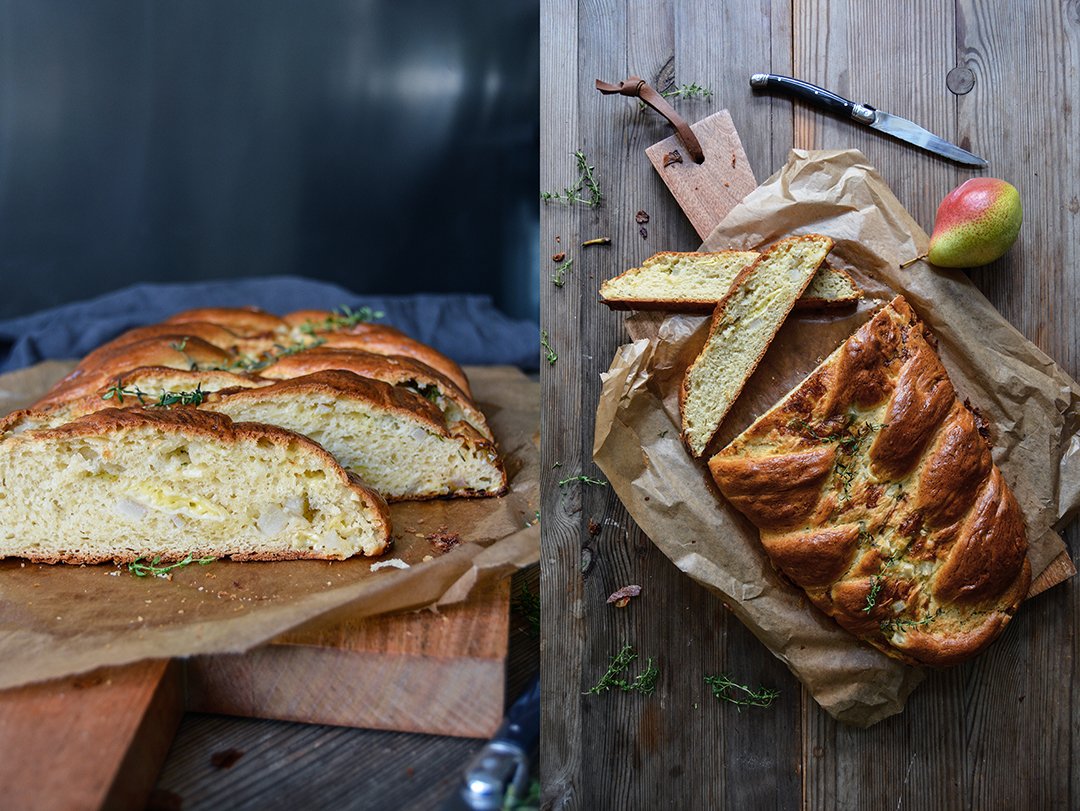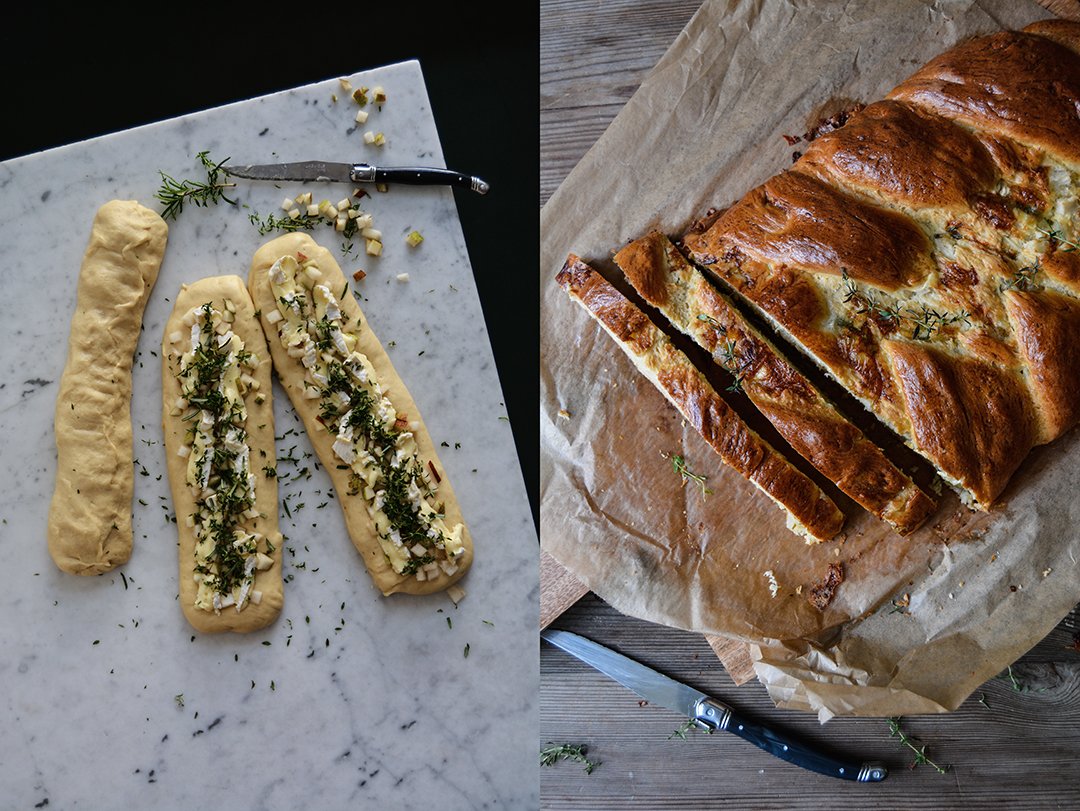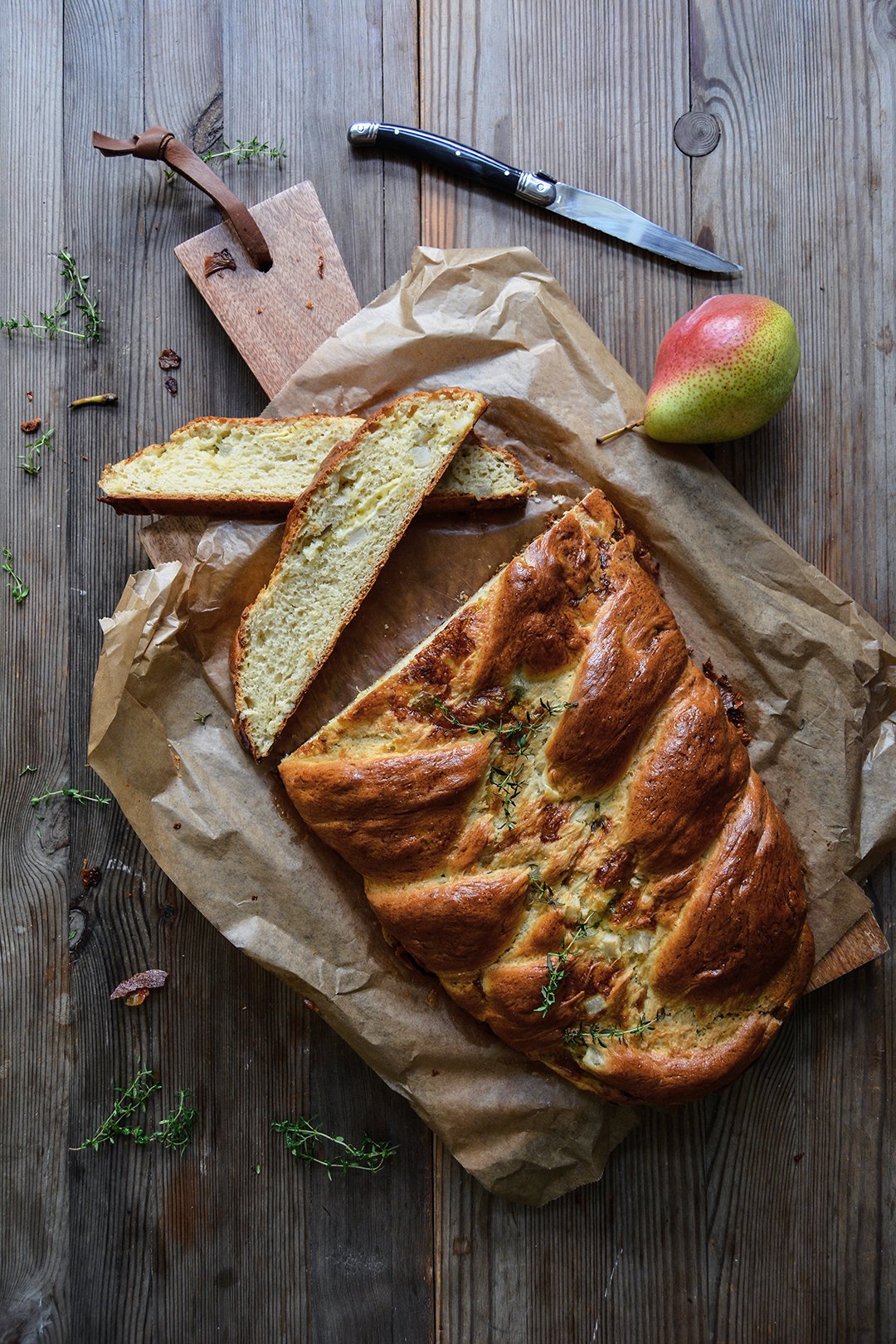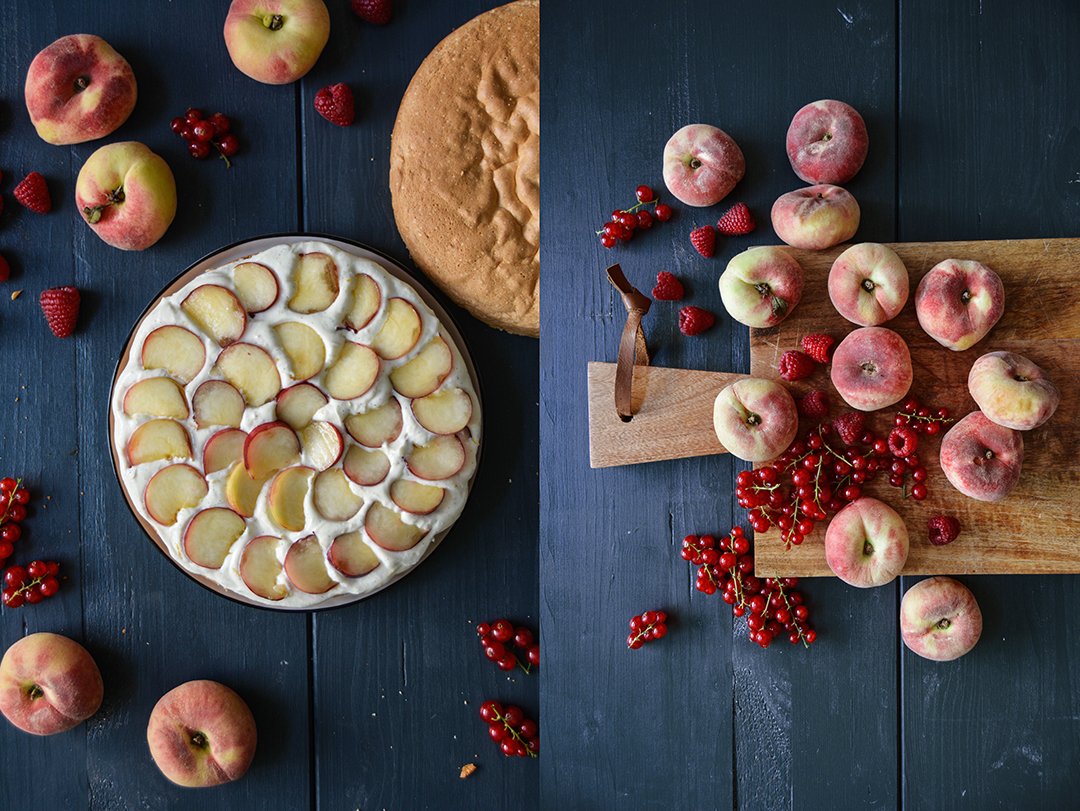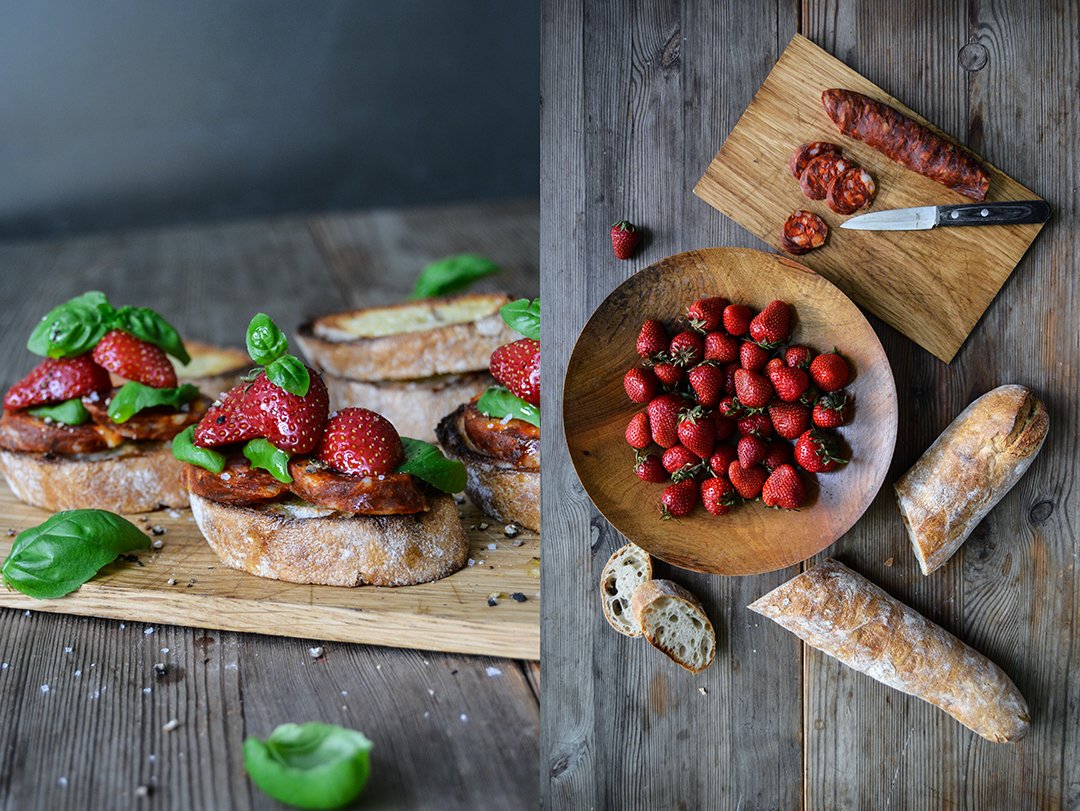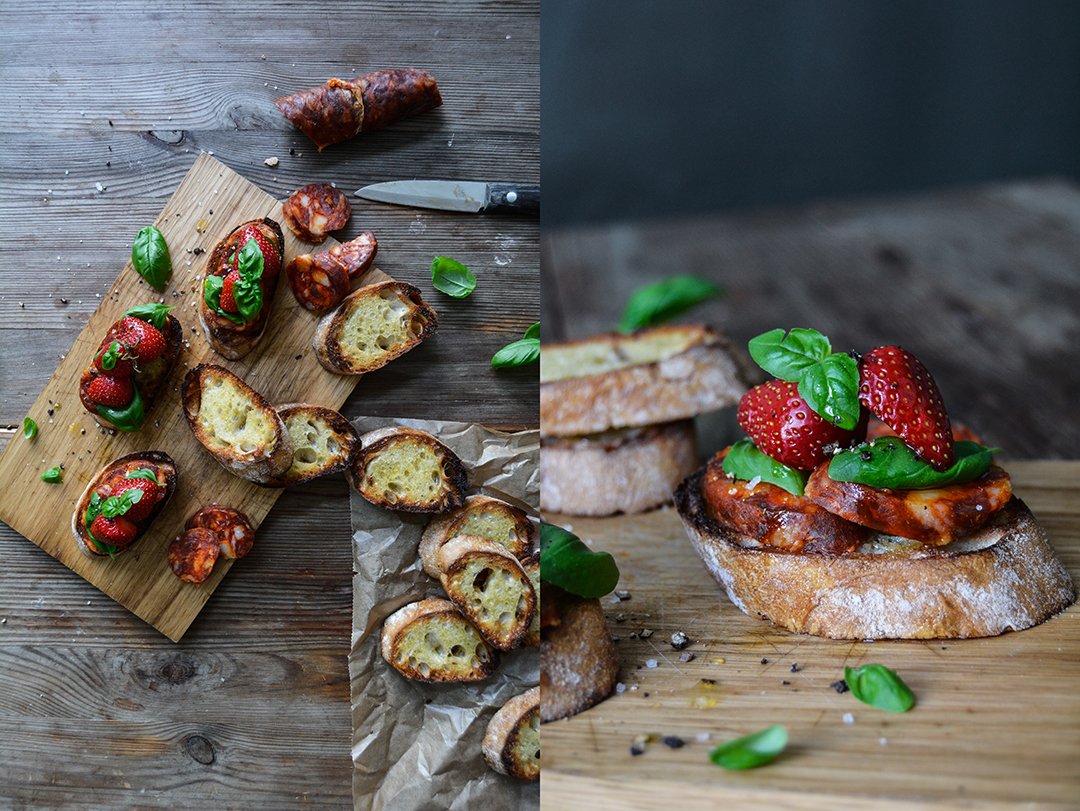Berlin & 365's Autumn Quiche with Squash, Taleggio & Sage
My editor at Prestel in New York asked me one day where I'd like to launch my new book. Berlin, I said, and Malta, of course, and London, and NYC, and the West coast this time, LA and San Francisco. It's nice to dream and imagine all these places on both sides of the Atlantic, to think of all the people I'd meet and who'd celebrate 365 together with me. I'm good at dreaming but I'm bad at not following a dream. It makes me restless, once my mind is set on something it doesn't want to stop until it gets there. Sometimes my dreams don't work out, sometimes they do - even though everybody around me has given up hope. And sometimes they happen to be even better than I hoped they'd be.
There are many ways to launch a book, but I wanted a feast - in six cities. There are many reasons why a dream works out, luck (always), persistence (tiring for everyone around), thoughtful planning (I studied architecture, I'm good at that), and help and support from others (and I got a lot of that). In the next couple months I'll share some impressions of the six 365 book launch events here on the blog, I'll write about the places and what I love so much about them, and about the people who made all this possible. And to give you a little taste of this book tour, I'll always share one of the recipes that we enjoyed at the events. So I'll start with Berlin, my home, the place where my adventurous journey began, and with the recipe for the Squash and Taleggio Quiche with Crispy Sage (you can find it in the book, recipe no. 287, and below). This quiche became the cover of 365 and quickly gained fans and fame all around the globe.
On the morning of September 23rd I started to feel nervous, it was the publication day of the German 365 and the day on which I'd step out of my comfort zone and talk about the book that I'd been working on for so many days and nights. It feels good when a book is out, you can't change anything anymore and at one point you even stop dreaming about gram-to-cup conversions but it's also the time when people start seeing what you've created, when it's not just you and the book anymore. It's scary.
So I kept myself busy during the day (the best strategy to calm my antsy mind), I went to the hair dresser (thank you Jay for dealing with my anxious self) and then drove straight to the Hotel de Rome, a former bank turned into the hotel of your dreams where 365 would soon see the most marvelous of celebrations. Türkan Arikan, the hotel's Director of Communications and the best event partner an author could ask for, had reserved the stunning roof terrace for our launch - my favourite spot for a summery sundowner - but Berlin's weather was set on drizzle, wind, and grey, no blue skies and golden sunset. We took over Hotel de Rome's imposing Opera Court with our 100 guests instead, nibbled on hearty tastings from 365 prepared by the diligent kitchen crew, and on the bittersweet recipe no. 70 from 365, Tangerine Jam Chocolate Brownies baked by Fine Bagels' fabulous Laurel Kratochvila. A fair feast needs wine and we happily filled our glasses with the wonderful reds, whites, and rosé from Meridiana Wine Estate in Malta (thank you Karl Chetcuti for making Maltese wine that fills my heart and every room on the book tour with so much joy). Florian Domberger baked and shared Berlin's best bread with us, his crunchy, spongy Beutebrot. And I had a very honest, intimate talk about the book with my friend Cynthia Barcomi. This woman manages to fit more into one life than anyone else and her laugh is so charming and infectious that you totally forget that you're nervous and that you're talking about something that existed, not too long ago, only in your head before it became a book. Could I ask for more? No, it was a feast.
Thank YOU so much for all the love and support that you've already shown for 365! If you have a few minutes and you're in the mood, it would be great if you could write a review for the book on Amazon (here are the links for the US, UK, Germany).
You can see all the pictures of the Berlin book launch event here on Facebook. And if you cook or bake recipes from the book and share pictures on Instagram, you can add #365TheCookbook so that they show up in the book's collection. If you feel like diving into the love that this book received so far, you can read about it here.
Squash and Taleggio Quiche with Crispy Sage
from '365 - A Year of Everyday Cooking & Baking' (Prestel, 2019)
Serves 4 to 8
For the filling
1 1/3 pounds (600 g) seeded squash, preferably peeled butternut or Hokkaido with skin, cut into 1-inch (2.5 cm) wedges
1 tbsp olive oil
Flaky sea salt
Finely ground pepper
3 large eggs
3/4 cup (175 g) sour cream (or crème fraîche)
1/2 cup (120 ml) heavy cream
1 tsp fine sea salt
Nutmeg, preferably freshly grated
5 ounces (140 g) mild, sweet cheese that melts well, such as Taleggio, fontina, or Robiola, diced
3 tbsp (45 g) unsalted butter
50 large fresh sage leaves
For the pastry
2 cups (260 g) all-purpose flour
1 tsp fine sea salt
1/2 cup plus 1 tbsp (130 g) unsalted butter, cold
1 large egg
Preheat the oven to 400°F (200°C).
For the filling, spread the squash in a large baking dish, drizzle withthe olive oil, and toss to combine. Season to taste with flaky sea salt andpepper and roast for 15 minutes then flip the squash and continue roasting for10 to 15 minutes or until golden and tender; set aside.
For the pastry, combine the flour and fine sea salt in the bowl of astand mixer fitted with the dough hook attachment. Add the butter and use aknife to cut it into the flour until there are just small pieces left. Quicklyrub the butter into the flour with your fingers until combined. Add the egg andmix with the hook until crumbly. Form the dough into a thick disc, wrap it inplastic wrap, and freeze for 10 minutes.
On a work surface, place the dough between 2 sheets of plastic wrap anduse a rolling pin to roll out into a disc, large enough to line the bottom andsides of a 12-inch (30 cm) quiche dish. Fit the dough into the quiche dish,pushing it into the dish, especially along the edges. Let the dough hang overthe rim a little or trim with a knife. Use a fork to prick the dough all over.Bake for 15 minutes or until golden. If the dough bubbles up, push it down witha fork. Take the quiche dish out of the oven and reduce the heat to 350°F (180°C).
In a medium bowl, whisk together the eggs, sour cream, heavy cream, andfine sea salt and season to taste with pepper and a generous amount of nutmeg.
Arrange the squash in a circle on top of the pre-baked pastry andsprinkle with the cheese. Pour the egg mixture over the squash and bake for 45to 55 minutes or until golden brown and firm. Take the quiche out of the ovenand let it sit at least 10 minutes.
In a large saucepan, heat the butter over medium-high heat, add thesage, and cook, stirring gently, for 20 to 30 seconds or until golden, green,and crispy—mind that the leaves don’t burn. Spread the sage on top of thequiche, sprinkle with a little pepper, and serve warm or cold.
Apricot and Basil Galette
Summer baking is the best baking, you can reduce additional sugar to a minimum and focus on some of nature's greatest gifts: stone fruit and berries. They are so packed with sweetness and flavor that adding too much sugar would feel like insulting their creator. However, sneaking in buttery pastry - no matter if it's a crunchy crumble, fragile short crust tart, or rustic galette - fortifies the produce's qualities and has only one effect: you'll want to extend teatime into dinner and just keep nibbling until the sun sets and the last crumb vanishes.
I went for a galette for this recipe because of its summery, picnic-style look but I sneaked a herb into the topping that gives it a slightly unusual touch. Apricot and basil is a fantastic combo for salads and there's no reason why they shouldn't mingle in a fruity tart topping. It's fresh, it's earthy, sweet, and sour, it tastes like a hot day in Tuscany.
Taking some time off for such a rewarding endeavor is the best therapy for a weary mind and soul. And I needed that. I lost my rhythm in the kitchen a little over the last year and half. I created new recipes every day, felt excited about the results and was pleased about being productive. All for my 2nd book, for 365. However, my natural flow of shopping, of planning our dinners, of meeting my man in the kitchen after work and pouring us a glass of wine before starting to cook, this wonderful ease has been disrupted. So much so that it's difficult sometimes to find my way back to my routine, a routine that became the compass of my days over the years. Always pointing towards my next meal, always pointing towards the kitchen. That is my comfort, my safety, and I'm trying to regain orientation.
What I love so much about cooking, about preparing my own food, is the fact that it's totally in my hands. That I can make myself - and others - so unbelievably happy by only throwing a few ingredients together and indulging in this experience on an emotional, sensory, but also intellectual level. I can't think of anything more satisfying than creating a meal that reflects the seasons, my mood, and the desires of my taste buds. This galette tastes heavenly, there's no doubt, it also let's July's plump produce shine, but it challenged me to be experimental, to rethink combinations of ingredients that seem a bit farfetched in the beginning. To combine fleshy apricots and fragrant basil - which usually shines atop my summery Caprese salad or Pizza Margherita - meant I had to open up for a new idea. And that's a good lesson. Always. Even in the most trivial situations. And by doing this, I'm slowly finding my orientation again. Towards the kitchen.
Apricot and Basil Galette
Makes one 23cm / 9″ galette.
For the pastry
180g / 1 1/3 cups plus 1 tablespoon all purpose flour
1 tablespoon light brown sugar
1/4 teaspoon fine sea salt
125g / 1/2 cup plus 1 tablespoon unsalted butter, cold
2 tablespoons water, cold
1 teaspoon cider vinegar
For the galette
4 large apricots (320g / 11 ounces) , pitted and cut in half,
plus 2 large apricots (160g / 5 1/2 ounces), pitted and cut into small cubes
50g / 1/4 cup light brown sugar, plus 1 teaspoon for the topping
1/2 vanilla bean, split and scraped
2 heaping tablespoons roughly chopped basil leaves
1 large egg, beaten
For the pastry, in the bowl of a stand mixer fitted with the paddle attachment, combine the flour, sugar, and salt. Add the butter and use a knife to cut it into the flour until there are just small pieces left. Quickly rub the butter into the flour with your fingers until combined. Add the water and vinegar and quickly mix with the paddle attachment until combined. Form the dough into a thick disc, wrap it in plastic wrap, and freeze for about 15-20 minutes, or until firm.
For the galette, in a small saucepan, heat the apricot cubes (not the apricot halves), the sugar, and vanilla seeds over high heat and cook, stirring occasionally, for about 5 minutes or until the apricots are soft and golden. Reduce the heat if the fruit starts to turn brown. Stir in the chopped basil, transfer to a medium bowl, and let the compote cool for a few minutes.
On a work surface, place the dough between 2 sheets of plastic wrap and use a rolling pin to roll out into a 30cm / 12″ disc. Remove the top layer of plastic wrap and replace it with a piece of parchment paper. Flip the pastry disc over, transfer to a wooden board, and remove the remaining layer of plastic wrap. Spread the apricot-basil compote on top of the pastry, leaving a 5cm / 2″ rim, and arrange the apricot halves, cut side down, on top of the compote. Fold the edges of the pastry up and over the fruit then gently press to seal the folds. Chill the galette, on the wooden board, in the fridge for about 15 minutes or until the pastry is firm.
Place a baking sheet in the middle of the oven and preheat the oven to 200°C / 400°F (conventional setting).
Brush the pastry with the egg wash and sprinkle with 1 teaspoon of sugar. Pull the parchment paper with the galette onto the hot baking sheet and bake for about 35 minutes or until golden brown. Let the galette cool for about 10 minutes before cutting. Serve warm or cold.
Swirly Peanut Butter Plum Buns and the blissful lesson of taking a break
I started writing a new book eleven months ago. Actually, eleven and a half months, it was Christmas Eve. The moment I decided to dive into this intense adventure again, I couldn't stop writing down one recipe after the other. It felt like the dishes had been inside my head, waiting impatiently to come out. And all this happened during Christmas 2017, my man thought I was crazy. At a time that's supposed to be calm and serene, surrounded by our sparkling Christmas tree and piles of cookies, listening peacefully to angelic carols, I stuck my head into my recipe notebooks and discussed undiscovered flavor combinations with my mother. By New Year's Day, I had an exaggeratedly long recipe list together and felt ready for a new book - and a holiday.
While I wrote my first book, Eat In My Kitchen, I often crossed my limits, I refused to respect them and felt totally squeezed out by the end of it. I didn't want to make the same mistake twice. So I asked for help and found the best kitchen assistant I could have asked for. He made the whole process of cooking and shooting a book far more smooth than I thought was even possible. He also took care of an impeccable playlist filling my kitchen with the most energizing tunes and making me dance around boxes of vegetables and bowls of cooked dishes. But most importantly, he taught me to take a break once in a while. We often went to a tiny coffee shop around the corner for an espresso and a chat to clear our heads. We started working on the book early February and since then I managed - more or less - to stick to this new ritual in my life: allowing myself to take a little break every day.
Sometimes, after an early morning cooking session followed by an extensive shopping tour for meat, fish, and vegetables, we'd get a bit more excessive and head over to a Berlin bakery famous for swirly buns. Whenever I felt tired and empty, a bite of their spongy cinnamon buns put me back on my feet and felt better than the most sumptuous meal in the world. That's the bliss that you can find in food - and in a break - it will always impress me how good it feels.
It's been a while since I cooked or baked for the blog, and for months now I had a flavor combination on my mind that I wanted to turn into a sweet treat and share: peanut butter and plums. We need to hurry, it's getting late, plum season reached its end, but you can still find some very ripe, sugary stone fruits at the markets. I decided to combine the duo with a recipe that Sofie Wochner from Marigold restaurant in Rome shared with me last summer. The Danish pastry chef treated me to the most wonderful, fragrant cinnamon buns in her kitchen, so I took her recipe for the yeast dough and turned it into Swirly Peanut Butter Plum Buns.
I will keep you posted about my new book, but it'll still take a lot of time until it comes out, as a book does when you want it to be a part of what you truly are. To be continued ...
Swirly Peanut Butter Plum Buns
Mind that the dough has to rise in the fridge overnight before you bake the buns.
Makes 10 swirly buns
For the dough
500g / 3 3/4 cups plus 1 tablespoon all purpose flour
75g / 1/3 cup plus 1 tablespoon light brown sugar
1 (7-g / 1/4-ounce) envelope fast-acting yeast
1 teaspoon ground cinnamon
1/2 teaspoon fine sea salt
255ml / 1 cup plus 1 tablespoon whole milk, lukewarm
1/2 beaten large egg (about 25 ml)
60g / 1/4 cup unsalted butter, at room temperature, divided into 6 portions
For the filling
250g / 1 cup creamy peanut butter
200g / 1 cup light brown sugar
300g / 2/3 pound pitted fresh dark plums
For the topping
1 large egg, beaten
1 tablespoon unsalted butter
In the bowl of a stand mixer fitted with the dough hook attachment, combine the flour, sugar, yeast, cinnamon, and salt. Add the lukewarm milk and 1/2 beaten egg and mix on medium speed for 10 minutes or until smooth. Let the dough rest for 15 minutes then continue mixing, adding the butter, 1 portion at a time, incorporating each portion of butter before adding the next one. Continue mixing on medium speed for another 3 minutes or until smooth. Transfer the dough to a clean bowl, cover, and let it rise in the fridge overnight.
Take the bowl out of the fridge and let the dough sit at room temperature for about 1 hour. Line a 24 x 18cm / 10 x 7 inch baking dish with parchment paper.
For the filling, combine the peanut butter and sugar. Cut the plums into small cubes.
Knead the dough for 30 seconds with your hands. Lightly dust a work surface and a rolling pin with flour then transfer the dough to the floured surface and, using the rolling pin, roll it into a 33 x 33cm / 13 x 13 inch square that's roughly 0.5cm / 1/4 inch thick. Spread the peanut butter mixture on top of the dough, leaving a 2cm / 3/4 inch border, then sprinkle the plums over the peanut butter, gently pushing them into the peanut butter. To fold the dough, divide it into 3 rectangles, don't cut the dough, just leave a thin mark on top of the peanut butter. Starting with the long side of one of the rectangles and dusting off excess flour, fold the first third of the dough up and over the middle third of the dough, then fold the other outer third of the dough up and place on top of the 2 layers of dough to end with 3 layers of dough. Using a very sharp knife, cut the layered dough into 10 slices.
Quickly pull and stretch each slice of dough then twist into a long spiral, close in a loose knot, and transfer to the prepared baking dish. It'll be massy, don't worry, you can sprinkle any peanut butter and plums that fall out on top of the buns once they are arranged in the baking dish. Cover the buns with a tea towel and let them rise in a warm place for 1 1/2 to 2 hours or until puffy.
Preheat the oven to 190°C / 375°F.
Brush the buns with the egg wash then bake for 25 minutes, cover the top with aluminum foil, and bake for another 10 minutes or until golden brown and firm. Rub the warm buns with 1 tablespoon of butter and let them cool for at least 20 minutes before serving.
Roasted Grapes and Camembert Sandwich with Rosemary
My love for cheese is deep and passionate. I embrace the whole variety of soft and hard, young and old, of cow, goat, and sheep milk cheese without skipping a bite. However, I always had a particular pull towards the oldest, runniest, and strong-smelling examples.
In my late teenage years, I spent a romantic weekend in Paris. Aside from the usual sightseeing spots, the strolls through the stunning Louvre and Musée d'Orsay, long walks along the Seine and busy Boulevard Saint-Germain, I went straight for the city's boulangeries, pâtisseries, charcuteries, and fromageries. It was my first proper food trip, constantly carrying - and nibbling from - bags filled with baguette, croissants, pâté, tartes, éclair au café, and cheese. Whenever I spotted a bench or a park, I declared it my picnic zone and made it a moveable feast. It was summer and I bought so much cheese that I had to find a way to store all these rolls, rounds, and triangles. Our hotel room's mini bar seemed like the only suitable place to keep my fragrant treasures. Just as we left, as I collected my food and other belongings, I noticed a particularly strong odor of a very aged camembert escaping the tiny fridge. In that moment I pitied the future guests of our room, and it dawned on me that it would take days for it to recover from my visit.
Camembert always had a very special place in my heart. When it's young and firm, still a bit white and crumbly in the center, I enjoy it at breakfast on crunchy baguette. The flavour is mild and still developing. But when it's aged and so soft that it practically melts inside the white rind - my favourite - the cheese is at its tasty peak. Then it needs a glass of full-bodied Bordeaux, or ripe fruits or concentrated chutneys. Le Rustique manages to capture this quality of rich ripeness perfectly, the cheese is strong and creamy, packed with a sharp taste that makes it so special. So when the cheese makers from Normandy asked me to create a sandwich recipe for their famous round product wrapped in red gingham cloth, I knew it would need a potent partner. Grapes and cheese are a common couple, but when you roast the little fruits in the oven until they shrivel, their flavour concentrates beautifully. I balance their sweetness with fresh rosemary to add woody tones to a rather opulent sandwich of ripe camembert and roasted grapes.
Thanks to Le Rustique for sponsoring this post and reminding me of the little culinary adventures that I have in my life through one of my favourite treats: the wonderful world of cheese.
Roasted Grapes and Camembert Sandwich
Makes 2 sandwiches
300g / 2/3 pound seedless red grapes, on the vine
6 small sprigs fresh rosemary
Olive oil
Flaky sea salt
100g / 4 ounces aged, aromatic camembert, such as Le Rustique, cut into thick slices
2 rustic, white buns, cut in half
Preheat the oven to 220°C / 425°F.
Place the grapes and rosemary in a medium baking dish. Drizzle with 2 tablespoons of olive oil, gently toss to coat, and season to taste with salt. Roast for 30 to 35 minutes or until the grapes are soft and a little shriveled.
Divide the camembert among the bottom halves of the buns. Snip the grapes off the vine and arrange on top of the cheese and sprinkle with the roasted rosemary. Place the top on each bun and enjoy.
Meet In Your Kitchen | Emiko Davies & Marco Lami's Dolce Vita in Florence
Italy is a luscious feast, its abundant beauty captures all your senses. As soon as I cross the border into the boot, I don't even know where to start feeding my cravings, which food I should try first, which wine I should pick to fill my glass. You can't help it, you fall in love with this country, over and over again, every day. And when you leave, you don't know how you should ever put anything else into your mouth than the most perfect Truffle Carbonara from that tiny Trattoria in Orvieto, or the dark Chianti from that dreamy Fattoria enjoying spectacular views over San Gimignano. The kitchens and tables are always filled with the most wonderful treats waiting to be shared, the people have their own pace and a smile for you at any time, the past is treasured yet critically considered and wisely woven into the present.
We arrived in Florence on a cloudy day, the Tuscan hills spread out softly like open arms welcoming us to the next stop of our culinary trip around the world together with Zwilling. Before you even enter the region's capital, before the man-made Renaissance buildings, sculptures, and gardens take your breath away, it's nature's creations, the landscapes that you'll save in your head and never forget. It's a stunning scene, seemingly peaceful in warm, earthy colors, but like a romantic painting, you can feel that there's always the potential for more, a hint of drama in the air. Bright blue skies brushed with pastel-pink strokes are the background for cypress trees swaying silently in the warm wind, the darkest clouds part suddenly and let the sun break through to light up this glorious kingdom.
The farmers markets offer the most colorful produce. Fruits and vegetables grow happily under the Italian sun, and they are proudly celebrated in the country's various regional cuisines. Italian cooking follows one philosophy: use only the best products, don't distract from their quality, and be guided by sensible simplicity. Especially in the countryside, you can feel a lot of respect for nature and the will to go back to a more natural and sustainable way of growing produce and raising animals. The younger generation takes a look into the past to learn from the precious heritage of their ancestors. Traditional recipes are being modified yet never erased from the menu, they have always been an important part of the culture, they are memories of the childhood of every Italian and special treats for the rest of the world.
Somewhere in the soft hills behind Florence, between olive groves and cypress trees growing tall into the sky, you can find a heavy iron gate framed by a washed out yellow wall. If you walk though this gate, you'll see a group of old houses, a former farm, overgrown with ivy, the roofs covered in terracotta tiles, and the wooden shutters painted as green as the lush trees and bushes along the gateway. It's a little paradise in the heart of Tuscany, it's the home of Emiko Davies and her husband Marco Lami.
Emiko Davies is the renowned author of two celebrated cookbooks - Florentine: The True Cuisine of Florence and Acquacotta: Recipes and Stories from Tuscany's Secret Silver Coast - and she's also the voice behind her popular food blog of the same name. She lived in many countries, half Japanese, half Australian, and the daughter of a diplomat, she's seen the world, but when she met Marco, she lost her heart to this man and his home country. Emiko loves food and cooking, she has a background in art history and fine arts, so Italy, and especially Tuscany's traditional cuisine is a vast field for her to explore. She's fascinated by all the regions and landscapes, towns and villages, treasuring their own recipes. The style is Italian, always, but the interpretation is distinct. Everything is done for a reason in Italian recipes: the way an ingredient is used, the season and region that it is used in shapes every recipe. And its origin often lies in the past.
Emiko's eyes sparkle when she talks about historical cookbooks, about exhibitions at the Renaissance Palazzo Pitti in Florence showing still life paintings of solitary fruits at the Medici gardens. She finds inspiration for her creations at every corner, at the markets, in conversations with the farmers who share their family kitchen secrets with her. She often finds that many formulas, certain combinations and preparations, haven't changed since medieval times. The food that's been cooked in Tuscan kitchens for centuries still finds its way onto today's tables, the stories behind these recipes are still shared when the families sit together.
The cookbook author is lucky, she found her perfect match. Her husband Marco is the sommelier at the Four Seasons Hotel Firenze, he approaches wine with the same love, passion, and precision, with the same curiosity that his wife feels for food. He loves to dig into Italy's red and white classics and discover new tastes, the hidden gems from his country. To be able to chat about his finds and choices together with his guests and share the mutual love for good wine and food at the table is the greatest gift in his eyes. The story behind a wine maker, the philosophy, gets as much attention from him as the taste. "Ideally, you can taste the idea behind a wine."
Emiko and Marco, both experience food and wine with all their senses, but they also involve their intellect to discover new fields to learn from, to find new stories and flavors to stimulate their creativity. It's a passion vividly lived in their household and lovingly passed to the next generation. Their little daughter is already a skilled cupcake and cookie baker, watching what happens in her parents' kitchen with a curious eye. When we met, the young girl shared some of her baking secrets with me, just like her mother who prepared the fluffiest "naked ravioli" for us - Florentine spinach and ricotta gnudi.
In the next months, I’ll share many Meet In Your Kitchen features with you that took me to California, Italy, France, and Japan. Thanks to Zwilling for sponsoring these features for our culinary trip around the world!
Ricotta and Spinach Gnudi
By Emiko Davies, from "Florentine: The True Cuisine of Florence"
(published by Hardie Grant, 2016)
Serves 4
350g / 3/4 pound firm ricotta, well-drained
300g / 2/3 pound cooked, chopped, well-drained spinach (if making from scratch, you need about 1 kg / 2 1/4 pounds fresh leaves)
2 eggs, beaten
A pinch of salt, plus more for the water
A pinch of ground nutmeg
About 50g / 1/3 cup plus 1 tablespoon plain flour
50g / 3 tablespoons unsalted butter
20 sage leaves
Salt and pepper for seasoning
A handful finely grated Parmesan cheese, to serve
Mix the ricotta, finely chopped spinach, eggs, pinch of salt and nutmeg together in a mixing bowl. You should have a thick, compact mixture.
Place the flour in a shallow bowl.
With hands, roll walnut-sized spoonfuls of the gnudi mixture in your hands, and then in the flour until well-coated. Place on a lightly-floured board until they are all ready.
Prepare a large pot of water (salted with a spoonful of salt) and bring to a simmer. Carefully drop the gnudi into the water and cook for about 4-5 minutes or until they begin to float to the surface.
In the meantime, prepare the sauce by melting the butter in a wide pan over medium heat with the sage leaves. When butter is melted and before it begins to brown, add about 2-3 spoonfuls of the gnudi water and swirl the pan to create a thick sauce. Season with salt and pepper.
When gnudi are ready, remove them from the water with a slotted spoon and place in the sauce. Turn heat to low and swirl to coat the gnudi gently with the sauce. Serve immediately with the cheese.
Emiko, can you tell us a little bit about yourself?
I’m originally from Australia, but have been living in Florence since about 2005. I live in Stettignano, which is a little neighbourhood, hilltop town just outside of Florence and here from home I cook and write cookbooks and look after this wriggly one (her daughter, Mariú). I also write a lot of articles for other publications as well.
And you, Marco?
I’m originally from San Miniato, which is just outside Florence. I work with wine. I work as a sommelier in Michelin star restaurants and I help Emiko, or I try to help her as much as possible with cooking and looking after Mariú.
Why did you choose to dive into the cuisine of the Maremma region for your second book, Emiko?
The second book was basically inspired by 6 months where we lived in Porto Ercole, which is a little fishing village essentially, it’s quite small on Monte Argentario. It’s on the very, very, southern part of Tuscany, on the coast. It just struck me how different that part of Tuscany is from Florence and from the parts of Tuscany that are better known to most people. So I wanted to write about the cuisine there partly because it was so interesting being on the coast and having a cuisine that’s inspired by the seafood, as well as the mountains from that area. It’s really rugged and wild, and a mountainous area. And partly because it’s not very well known. So I wanted to tell the stories of this place that people don’t think of really as Tuscany. When most people think of Tuscany, they think of these rolling hills and olive groves and cypress trees around Florence, the Chianti or Siena, but I don’t think they think of the seaside, islands, and mountains, really.
How important is the connection between the recipes and the region where they come from?
In Italy, I think that every recipe is so connected to a place, either the landscape or the actual region. Even within Tuscany. This is something I wanted to show through the two cookbooks that I’ve written, even within one region the recipes can change from town to town. As many towns as there are in a region, you have that many recipes in many cases. With Aquacotta, talking about the Maremma, that was really evident. Even with towns that are only a 15 minute drive away from each other have their own versions of an aquacotta, for example, which is a soup. Florence itself, has dishes that you only find in the city of Florence. So not only are they Tuscan, they’re actually Florentine. Even a ten-minute drive outside of Florence, there are some dishes that you just won’t see anywhere else outside of that invisible boundary. That’s true for all of Italy – it’s the same! – which is why I really like to write about a place that I get to know by living here or even visiting. I find it just endlessly fascinating how a landscape, or the town culture or a city culture – but even smaller than a city, like what they call in Italian a paesina, a little town – changes from one place to the next.
So first it’s a place and then the recipes?
Yes, although sometimes it’s the recipe first and I ask “why is the recipe just like that? Is it always just like that?” And then you get to know that landscape and “Oh! It’s because the landscape is this way, or there are certain things that grow there, or certain things that have always grown there, or there are certain things that you only see in a particular season.” Everything has a reason, I find, with Italian recipes. There’s always a reason why there’s that particular combination of ingredients in a recipe and it’s usually to do with the landscape.
So, what’s next?
I have a book that I’m starting to work on, which will be family recipes. There will be a little bit of Tuscany, but also a little bit of some other regions based on Marco’s family history. So we’re going to the south of Italy, and also going to the north of Italy, and then meeting back in the center.
How do you develop and approach new recipes for your books?
It depends on how I come across it to begin with. But the way I usually approach a recipe, it’s often inspired by the market or the season, or visiting a place that I’ve just been to where I’ve tasted something and I want to recreate that recipe. Or if it’s the market, it’s because I’ve seen something really wonderful at the market and I really want to do a recipe. Then I really have to delve into finding out what is really the most traditional version of that recipe and why is it that traditional. So I often go into the history of that dish, I look at historical cookbooks – I love reading historical cookbooks! – so I’ll look at those, maybe talk to people. If it’s at a market, often people at the market know something. Or if it’s not from this region, then I try and talk to somebody who is from that region. So for example, I’ve got sitting in my fridge at the moment a recipe for quince. I found these beautiful quinces at the market and I just couldn’t resist – they looked so beautiful! – I just bought a whole kilo of them and then I thought later, what am I going to do with them? I wanted to try a recipe from Mantova (Mantua) and I just happened to be at the market with a friend of mine who is from there. She told me her aunt’s recipe for Mostarda Montovana, which is a really spicy fruit compote that you eat with cheese. That recipe is one that dates back to about the 13th century and there are many different ways to do it but I was looking at the very traditional ways. It’s amazing because it hasn’t really changed much since then. The recipe that my friend, Anna, gave me is more or less the same recipe that is recorded in cookbooks from centuries ago!
Does it happen very often that you find recipes that haven’t really changed much over the past few centuries?
Yes, a lot! Particularly a lot of Tuscan recipes are like that with no changes over centuries. They’re the same and that is also something that I find really fascinating because I come from a country which is so young and doesn’t have that deep rooted food culture. It’s really a mishmash of things brought from all over the world, in one place. So I’m always fascinated by these old, old recipes that haven’t changed for several hundred years.
Where do you find inspiration for your creative work?
The inspiration for my work really comes from a lot of things. The market, yes, and the season. As soon as it starts getting a little bit chilly, I suddenly start wanting to make soups and stews and baking things, for example. But I also get a lot of inspiration from historical books and cookbooks. I have an art history background and a fine art background so I also love looking at still-life paintings. In Florence, at the Petit Palace, for example, there’s a collection of paintings of still life. One of the Medici dukes had an artist paint all the different varieties of fruit that they had in their garden. So there are these paintings of just figs, and there are maybe forty or fifty different types of figs, each one painted singularly, and the same with apples, paintings of just apples, all the apples they had. And all the lemon trees – they had quite a big citrus collection…
So when you don’t know what to cook, you go to the museum?
Yes! I find it amazing when you see these things and it’s hard to find a lot of those old varieties of fruit, but now they are starting to come back. Well, somebody’s decided to care about it and has started growing these heirloom varieties and you can start to see them sometimes at the market. So whenever I see something kind of unusual and it looks like something from a Renaissance painting then I go “What is that thing?! I really want to cook with it! What can I do with it?” There’s a little old lady that sells fruit and vegetables in Piazza Santo Spirito and she has these heirloom apples that are about the size of an apricot…
…which you know from the paintings…
Yes! I did actually find them in a painting. She said they’re called Francesca apples and they’re from Florence and I saw them in one of these paintings… It’s amazing!
Marco, what makes Italian wine so special?
That’s a big question! So the special thing about Italian wines is – actually it could be a bit of a double-edged sword – is how complicated it is. A lot of wines in the world, new wine regions, even old wine regions, are quite simple to understand. Italian wines, what makes them different, is quite similar to the food. Every region has its own grapes and each grape is treated in a different way to make different types of wines. There are a lot of different wines to be discovered. So there are a few famous wines, a few famous names, but what is actually interesting is what’s hidden under those famous names in each of the 20 regions.
Do you have a favorite wine region?
No, I don’t have a favorite region. I don’t even have a favorite wine! As soon as a wine sparkles my curiosity, or makes me think a little bit it becomes a favorite. I think the good thing right now is that a lot of tradition is meeting with a lot of innovation, and as a general rule, things are getting simpler. There are a lot of wine regions that aren’t really famous that are now coming out with amazing stuff at good prices, which is also important for wine. For example, some parts of Sicily, like Etna especially. It’s for me, right now, one of the best regions in Italy.
What do you love most about your job?
I love talking to people who know more about wine and food than me, so learning! And the idea that wine and food are going back to an idea of simplicity and good stuff.
Is it just about the taste or is the philosophy also important to you?
It’s not just about the taste. The philosophy is sometimes more important, for me at least – knowing the context of something. If you consider wine like food, you cannot just concentrate on the taste. It’s like saying, this tomato is delicious but we had to chop down bushes, etc. to make it. The philosophy behind it is important, the idea of the produce is very important. I think what makes the difference between a good wine and a bad wine is actually what’s behind it. I mean, it’s almost strange for me to isolate the taste. Sometimes something can taste very good, but it’s kind of soulless. If there’s an idea behind it, it almost sounds very romantic, but it’s almost like you can actually taste the idea behind the wine. So sometimes the idea is more important than the actual taste… if you can talk about an objective taste!
Emiko, can you please tell us about the pasta with broccoli please, it’s such a sweet story… the famous pasta!
(Laughing) Pasta with broccoli was a very improvised dish, but it was the first thing that I cooked for Marco when we were very early on in our dating phase, very early on. I really didn’t have anything in my fridge! At the time, I was living in this tiny, tiny apartment – the fridge was basically a mini-bar so to begin with I never had much in there anyway. Marco happened to be over and he happened to mention that he was hungry and I said, “Well, do you like broccoli?” and he said, “yes” which I found out later is….(Marco)…a total lie!It’s not his favorite food! If you couldn’t tell by the favorite things I like him to cook, he’s really into… he’s a protein man, less of an only vegetables man. But it was the only thing I had in my fridge so I made pasta with broccoli, a bit of garlic, some Parmesan cheese…
And did you like it, Marco?
I loved it.(Emiko, laughing) He said, “I’m going to marry you!” when he took a bite of it.
If you could choose one person to cook a meal for you, who and what would it be, Emiko?
It would maybe be my grandmother, my mother’s mother, who passed away about 10 years ago. I would just ask her to make me a normal dish that she would make on any normal day. Something that I have lots of memories of. When I was eating her food I was a lot younger – I wouldn’t have recorded everything like I do now when I’m eating with somebody, where I mentally note everything about the dish! I would definitely have another one of her dishes.
And you, Marco?
It would definitely be my grandmother and one simple dish that I’ve been trying to make as well as she used to but it never works out really. It’s the simplest thing. A piece of meat, crumbed with Parmesan, cooked in butter and white wine. For some reason, it just doesn’t come out as nice. And the best part is actually not the meat itself because it’s just a piece of meat, but it’s the sauce that you could probably finish off a whole loaf of bread in it.
Thank you, Emiko and Marco!
Meet In Your Kitchen | David Kurtz & the best Cubano Sandwich in San Francisco
A food loving friend of mine who lives in San Francisco told me, if you come to California, you must (!) meet David Kurtz and visit his Homage restaurant in Downtown. I trust my friends, especially when it comes to food, so I emailed David that same evening, not only receiving an answer that he was looking forward to cooking with me, but also to showing me around his hometown and spending a day together to give me an insight into his charismatic city that has so many faces.
The first thing that people think of when it comes to San Francisco is the Golden Gate Bridge and – if you talk to bread obsessed foodies and Instagrammers – the famous Tartine Bakery. The bakery is a temple for baked goods that one shouldn't miss, the bridge, however, is a moody diva that is hard to catch. San Francisco is a place of extremes when it comes to the weather, a fact that I had totally forgotten about and wasn't really prepared for. You can be spoilt with blue skies, sunshine, and summery temperatures in one second, then walk two blocks and be swallowed by mist and end up shivering in the cold. It was a bright afternoon as we drove to the famous bridge, impatient excitement in our faces ready to capture its majestic elegance, yet to find ourselves fighting against thunder and rain as we arrived was sobering. Needless to say there was no bridge in sight, but seeing the clouds climbing the hills behind the bridge and filling the bay with darkness and lightning faster than one can run was just as impressive.
The day we met David offered this exact spectrum of experiences, in food, weather, and sceneries. We started at the chef's wonderfully relaxed, casual, yet elegant Homage restaurant, a culinary gem tucked in a little side road surrounded by high office buildings. It's a tranquil oasis in the center of the vibrating buzz of this city. Sitting outside at one of the bistro tables, with a glass of Californian wine in my hand and a scrumptiously dripping sandwich on a chopping board right in front of me, was one of the best memories that I took home with me from this trip. This sandwich, the Cubano, is truly addictive and so famous that, according to David, it would cause a riot if he ever dared to take it off the menu. Imagine the best homemade baguette brushed and grilled in tasty pork fat (homemade lard), filled with succulent anise braised pork shoulder, hot smoked ham, Swiss cheese, mustard, dill pickles, and even more pork fat. It's the best sandwich I ever had in my life.
But before I could take a big bite of this unforgettably delicious lunch snack, David and I met two days before to prepare the dough for the bread in his kitchen and give it time to rise and rest. It was a Saturday morning and David and his lovely assisting, coordinating, and always helping 'right hand' Anja welcomed me and my film crew at Homage. David has the kind of voice and aura that calms you down immediately, whatever instructions he gave, I gladly obeyed and followed, enjoying to learn how to make the restaurant's beautiful baguettes and also being introduced to David and Anja's friends and suppliers at the utterly stunning Ferry Plaza Farmer's Market. The market is their weekly shopping date, it's a mecca for fresh produce. I've seen quite a few markets in my life, but this one is impressive, not only due to its setting right at the bay, but first and foremost because of the freshness and variety of the produce that the farmers offer at their stands:
Tomatoes kissed by the sun in all shapes, sizes, and colors; a sea of polished peppers; fragrant bundles of cilantro, basil, bay leaves, mint, and purslane; farmers' stands specialized in beans (like Romano and Cranberry Beans), or figs, 8 or 10 different kinds of figs gently laid out in baskets, or a stand putting the spotlight on plums, peaches, and nectarines, run by a woman with the sweetest smile, Aomboon Deasy. Each person, each stand at the market focuses on the prettiest crisp fruits and vegetables, celebrating its taste and beauty. One stand in particular left me in an awe: piles of Baby Curly Kale, Red Russian and Dino Kale, green and red dandelion, each leaf packed with so much pungent flavor that you want to nibble them straight out of the baskets (which we did).
I found the perfect partner for my market visit, David and I love food so much so that when Anja gave me a beautiful flower bouquet at the market, both David and I started eating the petals. Like I said, when he tells me in his trustful voice "Meike, you can eat this", I'll eat it! But apart from flowers and greens, I also tried the crunchiest spicy kimchi, candy-sweet September strawberries (a luxury for a German girl who's used to a rather short season of this fruit in her own country), ripe dates right off the vine, and the Rebel Within, a savory muffin filled with a soft boiled egg, sausage, Asiago cheese, and spring onions. It was heaven.
After the 'hard work' at the market and in the kitchen, we spoilt ourselves with a little feast at Nopalito, David's favorite Mexican restaurant. They cook delicious organic classics, like ceviche verde, enchiladas de mole con pollo (shredded tender chicken in a deep rich chocolaty sauce), and grilled fish tacos, all washed down with Michelada, Mexican beer with tomato, jalapeno, orange, lime, and salt – which was quite an experience. And after the meal we went for a walk at Golden Gate Park, where we were supposed to forage for forest snacks that one can find in a city if you keep your eyes open, but we chatted the time away. Wrapped in dense mist hanging heavily in the air, I was amazed by the beauty of the ever changing weather and the surprising scenes that it causes, and by David's philosophy and thoughts about the food that he celebrates at his restaurant.
Homage is a very, very special place that I'll always go back to when I'm in San Francisco, because of David and Anja, because of the food that's created and put together by the chef and his team with so much love and attention to detail in every single ingredient, because of this warm atmosphere that welcomes you as soon as you open the heavy door flanked by the restaurant's black facade, an atmosphere that makes you never want to leave again. And if you want to take a piece of it with you, you can grab a jar of the homemade pickles, jams, or a bottle of the wines and beers brought to Homage by David's friends, a bunch of people who find satisfaction in creating products of outstanding quality, just like David. And thanks to them we enjoy treats that taste so good - maybe because of the last ingredient that David listed in the recipe for his Cubano sandwich that he gave me: Love.
In the next months, I’ll share many new Meet In Your Kitchen features with you that took me to California, Italy, France, and Japan. Thanks to Zwilling for sponsoring these features for our culinary trip around the world!
David Kurtz' Baguette and Cubano Sandwich
David mills the grains for the flour that he uses for this recipe himself, however you can also use store-bought flour. It's recommended to work with grams instead of cups, as it's important to use precise measurements for this recipe.
For the baguette
Makes 3 baguettes
519g water (lukewarm)
30g honey
23g SAF instant yeast
875g all purpose flour
60g fresh whole wheat flour
Or if available (instead of the whole wheat flour)
23g hard red wheat flour
23g soft white wheat flour
14g rye flour
157g good quality lard (cold)
20g sea salt
In a large bowl of a stand mixer, using a fork, combine the water, honey and yeast, let it sit for a couple minutes.
In a large bowl, combine all the flours, add to the yeast mixture and, using the hook, mix for a few minutes or until well combined. Add the lard and, using the hook, continue kneading for a few minutes or until the dough has come together. Add a little more flour if it's too sticky or, if it's too firm, add a little (!) more water. Add the salt and continue kneading until well combined and firm. Form a ball, place in a clean bowl, and cover with a damp towel. Let the dough sit in a warm place for 1 hour. Turn the dough completely over releasing built up CO2 and let rise again for another hour, covered with a damp towel.
Line a baking sheet with parchment paper.Punch the dough down, take it out of the bowl, and divide equally into 3 pieces. Roll into smooth balls and let bench rest for 10 minutes under a damp cloth. When fully rested, take one piece of dough and stretch and pull it into a longish rectangular shape (about 14x5.5" / 35x14cm). Carefully flip 1 long side over until it reaches the middle of the rectangle, mind that no air is trapped in the fold. Then flip the opposite long side over, so that you end up with 3 layers of dough folded on top of each other. Using your fingers, pinch the fold all the way to seal well. Gently roll the dough into a long, thin sausage shape, then carefully, but quickly transfer to the lined baking sheet (the pinched fold should be on the bottom side). Continue forming the remaining 2 baguettes and transfer to the lined baking sheet. Cover with a damp kitchen towel, transfer the baking sheet to the fridge, and let the baguettes rest in the fridge overnight, further developing flavor and retarding the yeast activity.
Preheat the oven to 350°F / 175°C (convection setting). Take the baguettes out of the fridge when the oven is hot and ready.
Spray the baguettes with a little water and bake for 6-12 minutes or until the crust is golden, spraying them with water once or twice while baking. Internal temperature of the bread should be 210°F / 100°C when fully baked.
For the Cubano sandwich
Makes 1 sandwich
1 large piece of fresh baguette, cut in half
Dijon mustard
Whole grain mustard
2-3 thin slices hot smoked ham
1.5 ounces / 40g Swiss cheese (one that melts well), thinly sliced
2-3 anise pickled spring onions (or fresh spring onion), thinly sliced
2-3 dill pickles (gherkins), cut in half
5-7 ounces/ 150-200g braised pork shoulder (preferably cooked with anise and citrus), pulled or shredded
Good quality lard (pork fat)
Love, most importantly
Heat two heavy pans, preferably cast iron, over medium-high heat.
Spread the inside of the baguette with Dijon and whole grain mustard. Lay the ham on the bottom and topside of the opened baguette. Arrange the cheese, spring onions, and pickles on top of the ham. Spread the braised pork shoulder on top and close the baguette. Brush one pre heated pan with fresh lard, carefully place the Cubano onto the pan’s surface and brush more lard onto the top of the baguette. Squeeze, or press the Cubano with the other preheated pan directly on top of the sandwich. Cook in the pan, on medium heat, turning once, for a few minutes or until the cheese has melted and the crust of the bread is golden brown and crunchy.
Prepare with love and serve immediately with a large sliced pickle.
Watch my interview with David in San Francisco in September 2017:
Thank you, David!
Meet In Your Kitchen | Jessica Koslow's Sqirl in LA & the Magic of Sorrel Pesto Rice
It's captivating to watch a craftswoman concentrating on her material, a carpenter choosing the right piece of wood, a tailor feeling the fabrics, or a chef taking about a new recipe and picking the right ingredients. Jessica Koslow is a craftswoman, but she's equally an artist gifted with a huge sense for freedom and creativity and this shines through every single one of her creations. She's also a scientist who critically re-thinks all the single components of a dish until the final result is complete, until the textures and flavors feel aligned, until it looks deliciously tempting. This woman is so much, which makes her one of the leading figures of a new powerful movement of female chefs in California, but also in the rest of the world.
Sqirl is located just around the corner from Vermont Avenue that leads straight to Griffith Park, the restaurant is almost unspectacular, pleasantly unpretentious and casual, but the dishes that come out of the kitchen can easily compete with Michelin starred restaurants. The open kitchen works smoothly, peacefully, every chef seems to deeply enjoy the part they have in the Sqirl universe, it's a bit like friends cooking, just more precise. Like the Sorrel Pesto Rice, inspired by Pierre Troisgros, the father of the nouvelle cuisine movement, that blew my mind: Kokuho rose brown rice, sorrel pesto, preserved meyer lemon, lacto-fermented hot sauce, watermelon radish, French sheep feta, and a perfectly poached egg spreading its shiny liquid yolk all over this vibrant composition. And the Sqirl Chicken Salad with Marin Sun chicken, bok choy, dehydrated citrus and root vegetables, grated carrots, and black garlic vinaigrette balances crunch and tenderness, sweetness and bitterness, it's a dish that excites and satisfies.
Jessica comes across as very relaxed, she laughs a lot, but when you ask her a question she pauses and takes her time to think, to answer with the same precision you can find in her dishes, in the same way that she designed her restaurant, and how she put her first cookbook together, Everything I Want to Eat: Sqirl and the New California Cooking. There is a vision that only she can see that seems to guide her in the right direction. She used to be a competitive figure skater which explains her discipline and dedication, and when she stopped at 19, she channeled her obsession into something new: food.
From then on it was all about cooking, eating, and tasting. She was fascinated by the moment when you put the first bite into your mouth and you're overwhelmed. That's the experience she wants to create at her restaurant and she knows that she only has this first second to reach and convince her guests' taste buds. She and her team are gifted with outstanding produce, which she honors in her creations and that she receives from farmers who are friends and part of her community. This is the foundation of her work: "Raw produce defines a season, it's the passing of times and in California, thankfully, it's such a delicious marker of time. Our produce is an exciting time stamp and a building block from there." The Sqirl world is about dishes that feel familiar and unfamiliar at the same time, they create comfort and inquisitiveness, it's about different layers and textures, using the raw natural produce, but also playing with it, fermenting, pickling, or dehydrating it. As exciting as it is to eat this woman's food, it's a pure pleasure listing to her words.
Sqirl is a breakfast and lunch spot only, but in 2018 Jessica will open a dinner place for all her begging, hungry fans, called Tel - keep your eyes and ears open!
In the next months, I’ll share many new Meet In Your Kitchen features with you that took me to California, Italy, France, and Japan. Thanks to Zwilling for sponsoring these features for our culinary trip around the world!
Jessica Koslow's Sorrel Pesto Rice
Serves 6
3 cups (600 g) medium-grain brown rice, preferably Kokuho Rose
Fine sea salt
½ cup plus 2 teaspoons (130 ml) extra-virgin olive oil
1 cup (25 g) lightly packed kale leaves (stems removed)
2 cups (50 g) lightly packed chopped sorrel leaves
3 tablespoons fresh lemon juice
2 tablespoons chopped fresh dill, plus more for serving
1 Preserved Meyer Lemon, flesh removed, peel finely chopped
2-4 small watermelon radishes, very thinly sliced
¼ cup (60 ml) Fermented Jalapeño Hot Sauce
¾ cup (85 g) crumbled sheep’s-milk feta
6 poached eggs
Fleur de sel
Freshly ground black pepper
Boil the rice in plenty of salted water until it’s tender, 30 to 45 minutes. Drain and let cool.
Meanwhile, make the sorrel pesto: In a blender or food processor, combine ½ cup (120 ml) of the oil, kale, sorrel, and 1 tablespoon of the lemon juice. Blend until smooth, stopping and scraping down the sides as needed. Season with salt to taste.
In a large bowl, toss the rice with the dill, preserved lemon peel, 1 tablespoon of the lemon juice, and the pesto. Taste and add a bit more salt, if needed.
In a small bowl, toss the radish with the remaining 1 tablespoon lemon juice, the remaining 2 teaspoons oil, and a pinch of salt. Set aside to marinate for a few minutes, until the radish is pliable and tender.
To serve, divide the rice among six bowls. Spoon a line of hot sauce across the rice. Arrange a little clump of feta on one side and a rosette of radish slices on the other side. Set a poached egg in the middle of each bowl and season it with fleur de sel and black pepper. Garnish with a tiny sprig or two of dill.
Watch my interview with Jessica in LA in September 2017:
Thank you, Jessica!
Jessica Koslow
Meet In Your Kitchen | Urban Farming and a Garden Salad at LA's Farm Lot 59
A 1-hour drive, leaving the skyline and the buzz of Downtown LA behind, and you're in Long Beach, still LA county, yet a totally different scene. As we left California Avenue in the south and drove our bulky van down a dusty road for a new Meet In Your Kitchen feature together with Zwilling, the inspiring urban farmer Sasha Kanno welcomed us with a big smile in front of the gate of her green oasis, Farm Lot 59.
Sasha is a woman with a strong vision and principles, she believes in honest food, available not only for herself, but also for the community that she lives in. She took over the land surrounded by urban industrial buildings in 2010 and turned it into a non-profit organic farm, practicing biodynamics and following the Waldorf School philosophy. The farmer who's fascinated by rare and heirloom varieties and who gets many of her seeds from a 100-year old seed company in Honolulu, is famous and loved by locals and chefs for her outstanding lettuce and herb mixtures. All year round, she puts an exciting seasonal bouquet together, of arugula, lemony blood sorrel, giant red-leaf mustard lettuce, basil (with a rough surface), huacatay (black mint), cilantro, fennel, tarragon, thyme, chocolate mint, and many more. Her edible flowers, such as pensi, dahlia, dianthus, calendula, lavender chamomile flowers, are a feast for the eye and an explosion of flavors for the palate.
However, as much as she loves to share the produce from her garden with other passionate lovers of natural, healthy fruits and vegetables, Sasha felt that there was more for her to do. She started an educational program of cooking and gardening classes, she wanted to bring the basics back to the table of our children: her tomatoes, beans, eggplants, pumpkins, squash (I learnt that you can even eat its leaves cooked like a vegetable), peppers, snake melon, and artichokes. She wanted them to smell again and listen to the sounds of the woods and fields, and taste pure unprocessed food. She saw city kids who were totally overwhelmed by this experience, being confronted by nature, even stressed some of them. Some of the most common fruits and vegetables had never been in the hands of these children before. It's an essential experience, if not a right to have access to food in its original form. Sasha takes responsibility to teach them about our fragile ecosystem, so that future generations adjust the way that we deal with ourselves, our food, and our environment.
The doors of Farm Lot 59 are open almost every day and it's worth visiting this green paradise framed by apple, stone fruit, and guava trees. You can buy the handpicked produce and humanely sourced meats, dairy products, and eggs from friends and other farmers at the farm's market stand at the street, the Farmstand 59. And then you go home and prepare the beautiful salad that Sasha made for us in her outdoor farm kitchen: a colorful tomato salad with the farmer's delicious basil vinaigrette featuring the pure taste and beauty of this sweet fruit and fragrant herb!
In the next months, I’ll share many new Meet In Your Kitchen features with you that took me to California, Italy, France, and Japan. Thanks to Zwilling for sponsoring these features for our culinary trip around the world!
Sasha Kanno's Tomato Salad with Basil Vinaigrette
Serves 4
For the dressing
1 cup (240ml) olive oil
2 tablespoons red wine vinegar
1 red onion, roughly chopped
2 cups fresh Tuscan basil
1 clove garlic
½ teaspoon haberno salt (haberno peppers mixed with sea salt)
For the salad
8-12 green, red and yellow ripe tomatoes (of various sizes), sliced
2 large handfuls mixed young lettuce greens
1 small handful edible flower petals
For the dressing, purée the ingredients in a blender until smooth and season to taste with salt. Add more oil if the dressing is too thick.
Spread the lettuce greens and tomatoes in a large bowl, sprinkle with the dressing and flower petals and serve immediately.
Watch my interview with Alana in LA in September 2017:
Thank you, Sasha!
Meet In Your Kitchen | Heather and Emily celebrate LA's vegetables at Botanica
One of the kitchens that I visited on my trip to LA - the first stop of my new adventure together with Zwilling - was at Botanica, a stunningly beautiful restaurant founded by the wonderful Heather Sperling and Emily Fiffer. Both women had been working in the food industry as editors on the East coast for more than a decade, but they were hungry for more. They chose LA to bring a project to life, giving it all their love, passion, and honest determination. An old run-down liquor store in Silverlake looked less than promising when they first saw it, but Heather and Emily knew from the start that this would be the right place to give their vision a home. They gutted it and after a year of sweat and work you can't even imagine how this gorgeous bright and airy space looked before the renovations. A tall wall touched up in a soft Tuscan pink holds the old wooden beams above the restaurant's rustic wooden tables and the little market where you can buy the products and produce used in Botanica's kitchen.
The two ladies also started an online magazine, a collection of the recipes used at their restaurant to complete their customers hungry needs: you can eat a dish at Botanica, fall in love with it so much that you want to cook it at home, buy the ingredients right away, grab the recipe from the magazine, and go straight to your own kitchen and cook it again.
Sitting at this restaurant feels a bit like being in Heather and Emily's home and this was an important aspect for them when they first started thinking about their restaurant baby. The design, the menu they put together, the way they work together with their employees, this all shows a philosophy of working and living together in a community. They have strong connections with the other restaurants in their neighborhood, many of which are also run by women, and together they put the spotlight back onto LA's culinary scene (like "Kismet" that I wrote about last week and Jessica Koslow's "Sqirl", which will be featured here on the blog in 2 weeks). They not only share the same work ethics, but also their farmers and suppliers.
And they all have one more thing in common, all these restaurants celebrate vegetables. Heather and Emily manage to turn a potato, cauliflower, squash, or carrot into a vibrant feast. They shift the traditional focus from meat and seafood centric dishes to roots, cabbages, and legumes. Botanica is not a vegetarian restaurant, but ribs, steaks, or fillets aren't the star of the meal anymore, they can be a part of a greater composition, add flavor, be a luxurious treat of outstanding quality, but they aren't essential anymore. And the two women's recipes are so fantastic that you won't even miss it, you just indulge in a dish like their seared vegetables with romesco (recipe below), which is so rich, balanced, and exciting that you don't ever think of anything but tasty vegetables. And apart from this more than satisfying pleasure for the taste buds, you can be sure that you just enjoyed food that is good for your body, locally sourced in a strong community that works with and not against nature and our environment.
In the next months, I’ll share many new Meet In Your Kitchen features with you that took me to California, Italy, France, and Japan. Thanks to Zwilling for sponsoring these features for our culinary trip around the world!
Heather Sperling and Emily Fiffer's Seared Vegetables with Romesco
Serves 4
For the romesco
4 red bell peppers
1 jalapeño, seeds removed
2 medium cloves garlic
¼ cup (60ml) olive oil
1 tablespoon sherry vinegar
1 small lemon, zest and juice
2 teaspoons Spanish smoked paprika
1 cup (140g) toasted almonds
1 large handful fresh cilantro leaves (about ¼ cup chopped)
Sea salt
For the vegetables
20 tiny potatoes (preferably purple), boiled in salted water until just tender, drained and cooled
Olive oil
Sea salt
Black pepper
Spanish smoked paprika
Broccolini, summer squash, romanesco, Brussels sprouts or cauliflower (or a mix)
3 leeks, white and light green part only, cut in half lengthwise
For the topping
About ½ lemon, zest and juice
1 small handful fresh cilantro flowers (or cilantro leaves)
Preheat the oven to 450°F (230°C).
To make the romesco: Roast the bell peppers until blistered and fully soft. Transfer to a large bowl and let them cool for a few minutes. Remove and discard the seeds and stems, collect the thick juices that run off the peppers. Peel the skin and set aside.
In a food processor, combine the roasted peppers and their skin, the jalapeño, garlic, olive oil, vinegar, lemon zest and juice, smoked paprika, almonds, cilantro, and a splash of the liquid from the peppers. Blend until fully incorporated, but not fully uniform; some texture is ideal here. Add more sherry vinegar, salt, olive oil, and cilantro to taste.
For the vegetables: Lightly crush each potato with the side of a knife. Heat a splash of olive oil in a pan over medium heat and sauté the potatoes on one side until just starting to crisp, then flip and crisp up the other side. Remove from oil and season well with salt, pepper, and a sprinkle of smoked paprika.
While the potatoes are crisping, prepare the remaining vegetables: Cut the vegetables into bite size pieces (except the leeks) and toss with olive oil, salt and pepper, then grill or sear until al dente, with nice char in spots. In a large pan, cook the leeks, cut-side down, until they get a touch of caramelized char, then flip and cook for a few minutes on the other side, until soft through. Cut in two-inch lengths, season, and set aside.
Mound the romesco in the center of a large plate and arrange the potatoes, leeks and vegetables in a ring around the purée. Garnish with a good drizzle of olive oil, a squeeze of lemon juice, lemon zest, a sprinkle of salt, and the cilantro flowers and serve immediately.
Watch my interview with Heather and Emily in LA in September 2017:
"I think that for many women in the industry, they are very aware that this is a moment in time when they can be actively involved in changing the culture of the restaurant world."
Thank you, Heather and Emily!
Limoncello Panna Cotta
Some years have the pace and mood of a little stream in the woods, burbling along quietly, without anyone really taking any notice of it. And then there are years that are more like a hungry wave, rolling like thunder and hitting the shore with a crash, ready to pull you off your feet and make you tumble in the most unexpected moments. 2017 had quite a few of these moments, whirling and twirling, they shook the world politically, socially, and environmentally, and also my own world on so many levels. It's exhausting when the ups and downs wear out the mind and squeeze it like a sponge, but it's also a challenge that forces us to question and grow in our own existence and that's its gift. I believe that our human mind needs to leave the known path once in a while, our comfort zone, that can easily become too comfortable and that makes us lazy. The irritating state of mess and confusion can be a great starting point to be brave and dive into the unknown, as much as I hate these moments as it's scary, I'm thankful, afterwards, when they force me to unfold the old, familiar pleats.
Just over 12 months ago, the Eat In My Kitchen book was sent out into the world and little did I know how much it would change my life and the way it used to be. In April 2017, Andrew Zimmern hung the medal for the James Beard Award for Best Cookbook in the General Cooking category around my neck, the state of bursting happiness, surprise, and thankfulness that I felt on that magical night in New York lasts until today. The world also revealed some of its culinary tricks and secrets to me as I travelled in America, Asia, and Europe during autumn. I was on the road for a new project and, for once, I let other people cook for me. I was introduced to the wonders of food in some parts of the world where I had never been before. It was pure bliss to experience new tastes and smells, to listen to unknown languages and learn about traditions and rituals that grew over centuries. And to see so many inspiring women in their kitchens, wherever I was, women who strongly believe in a gastronomic concept of respect and togetherness, women who create praised and highly celebrated restaurants, that made me happy and confident that the future will bring more and more of these fantastic female chefs into the spotlight.
In 2017, we all lost and gained, we gave and took, and as long as the exchange feels balanced, it was a good year. Before I pull the plug and go offline for a week, finally after 4 years of constant buzzing, I have one more thing to give to you: the recipe for this joy-bringing limoncello panna cotta. Now you have a sweet recipe at hand, for the moments when life gives you lemons.Enjoy food, wine, and especially time with the ones you love, have a happy Christmas and a joyful start to an exciting 2018!
Meike xxx
Limoncello Panna Cotta
Serves 2 to 4
gelatin sheets 2 1/2 (7 x 11-cm / 3 x 4-inch)
heavy cream 240 ml / 1 cup
whole milk 120 ml / 1/2 cup
Limoncello 60ml / 1/4 cup
lemon peel 2 long strips
granulated sugar 2 tablespoons
fine sea salt 1/8 teaspoon
lemon slices, very thinly cut for decoration (optional)
fresh mint leaves for decoration (optional)
Soak the gelatin sheets in cold water for about 5 minutes.
In a small saucepan, bring the cream, milk, Limoncello, lemon peel, sugar, and salt to the boil. As soon as the mixture is bubbling, take the pan off the heat. Squeeze the excess water from the soaked gelatin sheets, crumble into the warm cream mixture, and whisk thoroughly. Let the mixture cool in the pan, whisking occasionally.
Once the cream mixture is at room temperature—it will still be liquid—divide it between 4 120-ml /4-ounce ramekins. Cover them with plastic wrap and refrigerate for 1 hour. Transfer the ramekins to the freezer and chill for about 35-45 minutes or until set but not frozen. Alternatively, leave the ramekins in the refrigerator for about 3 hours or overnight.
Decorate the panna cotta with lemon slices and mint just before serving.
23 Recipes for Cozy Christmas Baking
Berlin, December 2017:
I'm sitting at my dining table, listening to Jingle Bells, wrapping Christmas presents, and waiting for the snow to fall. It's the last weekend before Christmas, the last chance to fill the kitchen with the tempting smell of cinnamon, cloves, and citrus fruits, cardamom, chocolate, and candied nuts, so what am I going to bake? I picked 23 recipes from the last four years of cozy Christmas feasting on Eat In My Kitchen and I love each one of them. Just a look at the pictures and my taste buds get excited. I can remember the woody notes of my Rosemary and Lemon Heidesand Cookies, the citrusy-buttery sweetness of my Mediterranean family's Maltese Lemon Christmas Cookies, the elegance of my mother's classic, her Linzer Cookies, and of course, my annual highlight, the best Vanilla Kipferl in the world. You can find a variation of this famous German cookie in my Eat In My Kitchen book, wonderfully fragrant Cardamom Kipferl. So, happy baking, treat yourself to a cozy weekend with the ones you love and indulge in the pleasures of Christmas baking!
Click on the titles for the recipes:
Chocolate, Orange and Cardamom Stollen
My granny Lisa was loved and adored for many of her baked goods. She truly mastered the German Sunday coffee table, filling the house with the sweetest smell of butter, sugar, and eggs every weekend. To please her six children's cravings, and later a growing pack of grandchildren, she sometimes baked seven different cakes in one day. Sponge and fruit cakes, cream tarts and crumbles were often lined up on her kitchen counter and doubtlessly influenced my own baking habits. Her Donauwelle - a marbled cake with cherries and buttercream - will always be my favourite. It's the taste of my childhood - and the beginning of my ever hungry sweet tooth.
Six to eight weeks before Christmas, Lisa used to take orders from friends and family for another one of her celebrated classics: stollen. It's a German staple that you can find at every bakery, in every household as soon as the Christmas lights leave the boxes to twinkle behind wintery windows. The original stollen is quite a dense treat, it's a heavy yeast dough, the texture is crumbly like a fruit bread, but it has richness and depth. Raisins, candied orange and lemon peel infuse the cake for weeks while it sits wrapped in parchment paper in the darkness of the pantry. The top brushed with warm fat and then generously dusted with icing sugar, preventing it from drying out and giving it its snowy white Christmas look.
You can find various interpretations of the basic formula and fill the cake with marzipan, hazelnut or poppy seed paste to add taste and moistness. This is the first stollen recipe I ever created and I wanted it to be an aromatic firework of flavours without distracting from the classic's qualities. I went for bittersweet chocolate chunks, candied orange peel, and a touch of christmassy cardamom and aniseed. I'm more impatient than my granny, so we ate the stollen immediately. There's only one treat that I manage to wait for and that's English Christmas pudding.
Thanks to Kærgården for sponsoring this post, thanks for reminding me of my granny's kitchen and inspiring me to create my first stollen recipe!
Chocolate, Orange and Cardamom Stollen
For the stollen
plain flour 450g / 3 1/2 cups (divided)
granulated sugar 70g / 1/3 cup
ground cardamom 5 teaspoons
aniseed, finely ground in a mortar, 1/4 teaspoon
zest of 1 large orange
fast-acting yeast 2 sachets (7g / 1/4 ounce each)
water, lukewarm, 150ml / 2/3 cup
fine sea salt 1/8 teaspoon
soft butter, unsalted, 250g / 9 ounces
candied orange peel (preferably organic) 100g / 4 ounces
almonds, roughly chopped, 150g / 5 ounces
bittersweet chocolate (50%), roughly chopped, 170g / 6 ounces
For the topping
butter, unsalted, melted 50g / 2 ounces
icing sugar, sifted, about 4-6 tablespoons (to taste)
ground cardamom (optional, to taste)
In the large bowl of a stand mixer, combine 260g /2 cups of the flour, the sugar, cardamom, aniseed, orange zest, and yeast. Add the water and, using the hooks, mix for about 2-3 minutes or until well combined. If the dough is too sticky, add a little more flour. Cover the bowl with a tea towel and let the dough rise in a warm place, or preferably in a 35°C (100°F) warm oven, for 45 minutes or until almost doubled in size.
If the dough has almost doubled in size, add the remaining 190g / 1 1/2 cups of flour, the salt, butter, and orange peel and, using the hooks of the stand mixer, mix for about 3 minutes until smooth. Add the almonds and chocolate and continue mixing until well combined. The dough should be soft and shiny, but not sticky. Take the dough out of the bowl and, using your hands, knead for about 1 minute.
Line a baking sheet with parchment paper.
Transfer the dough to the lined baking sheet and form a short-ish loaf-shape. Flatten the dough a little, flip one long side over until it reaches the middle, then flip over the other long side (see 6th picture), pushing the layers softly together, but don't flatten the loaf, it will expand when it's in the oven! Cover with a tea towel and let rise for about 20 minutes.
Preheat the oven to 175°C / 350°F.
Bake the stollen for about 45-50 minutes or until the loaf is just baked through.
For the topping, brush the top of the warm stollen with the melted butter and dust immediately with icing sugar. If you'd prefer the cardamom to be more present (I recommend to try the stollen first), combine some icing sugar with additional cardamom (to taste) and dust the top of the stollen.
You can serve the stollen immediately, yet I prefer to eat it when it's cool and the chocolate isn't soft anymore. Keep it wrapped in parchment paper and aluminium foil.
Molly Yeh's Chocolate Tahini Cake with Tahini Frosting
Time can feel like a race, it drags you back, you try to keep up, but there's no way to stop. My summer flew by and then there was autumn, as quick as a storm that sweeps all the leaves off the trees, within one night they are all gone.
My last post was on August 27th. Since I started these pages, my Eat In My Kitchen blog, I have never 'abandoned' it for such a long time. It used to feel weird if I didn't come back here every day, like in the first year, or at least every few days like I did in the past 3 years. It was my routine that I loved and hated. Sometimes I did feel pressured, just by myself, and the best thing to escape pressure, at least for me, is another project that sucks me in with such intensity that all my brain cells are too busy to think about anything else. I'm involved in a new project at the moment that I'll only be able to share with you at the beginning of 2018, and this project took me around the world within just a few weeks. I met the most amazing people, I felt hungry and inspired every day, I pushed my borders, which I need to keep my creativity flowing and which I could only do because I had an amazing team around me. So far we went to California, Italy, France, and Japan, and there will be more countries to come. It's quite a journey.
These trips in the past 2 months were one of the reasons why I stayed away from my kitchen, why I didn't go to the farmers market as often, why I didn't experiment, fail and succeed at my cooker, but I discovered new worlds and culinary universes that I can't wait to include in my own cooking - once I'm fully back home and ready to cook.
The second reason I stopped writing, is one that hit me deeper, right into my head, my heart, and my bones. On October 16th, Daphne Caruana Galizia was brutally killed in Malta. She was the most wonderful woman, the bravest I know, she was a mother of three young men, and she was a friend. Daphne fought for freedom and justice, for all of us, she was a well known investigative journalist and blogger. It was late in the evening and I was in Tokyo when I found out, I could only scream and run outside into the dark. Since then, I've been angry, too angry, which never helps anybody. I tried to find words for what happened, but I didn't manage. A few days after I found out, I started writing a post to share here, but it was just anger screamed out into the world. You can say that this is a food blog, and you're right, but this is a food blog written out of my perspective, so whatever influences me as a person will find its way into my kitchen, onto my table, and onto this blog. I can't really say more, my words aren't really back yet, I still feel numbed, but I wanted to put what happened in words, that Daphne Caruana Galizia was killed for saying the honest, painful truth, for being critical, for fighting for our freedom. I will never forget her and my thoughts are with her and her family every day. One of her sons, Matthew Caruana Galizia, continues her work, he just won the Pulitzer prize as a part of a group of investigative journalists who disclosed the Panama Papers first and then the Paradise Papers just recently. We have to support the ones who are brave enough to open their mouth and talk, maybe louder than we'd dare to do, and we have to show that they are not alone and that we are with them.
My mother taught me that life can be beautiful and brutal and that we have to deal with both sides. Sometimes they lay so close to each other that we don't even know how to deal with it. We enjoy the heights to the fullest and then, in the next second, we seem to drown. The place where I often go to when I feel battered by life, is my kitchen, I cook and I bake. And although I've neglected this space so much recently, I have long lists of kitchen projects that I want to dive into during Berlin's long lasting winter.
To cook - and bake - from my friend Molly's Molly On The Range cookbook was on the top of my list, her book came out at the same time as mine, a year ago. Molly and I just met again while I was in California, her compelling, charming way to talk about food and life in general never ceases to amaze me. Molly also knows how to make cakes look so pretty that you wouldn't dare to cut them, like her famous Funfetti Cake or her Gingerbread Farm, a replica of the actual farm where she lives with her husband (you can read her interview for our Meet In Your Kitchen feature in 2015 here). Molly is the kind of person who somehow manages to combine the talents of a perfectionist with the casual laid back attitude of a person who doesn't care about perfectionism at all. Molly's German book was only recently published and when I got the book and spotted the recipe for today's chocolate tahini cake, I was hooked as soon as I read the title.
This was the first cake that I baked in months, and I didn't even notice how much I missed baking until I turned on the oven and thumbed through the pages of Molly's beautiful book. Sometimes, the best thing I can do is to take some time for myself in my kitchen, with eggs, butter, and sugar (and some tahini), and listen to Molly and bake this cake that tastes so unbelievably perfect. It's chocolate, it's tahini, it's sweet, and it's all I needed at the moment to feel ready to face the world again, with all its beauty and its brutality. Thank you, Molly!
Chocolate Tahini Cake with Tahini Frosting
from Molly Yeh's 'Molly On The Range - Recipes and Stories from an Unlikely Life on a Farm'
I only made half of this recipe and decorated the cake with dates and sesame seeds.
Makes one 2-layer 8-inch (20cm) cake or 24 cupcakes
For the cake
1 3/4 cups / 350g sugar
1 3/4 cups / 220g flour
1 cup / 100g unsweetened cocoa powder
1 1/2 teaspoons kosher salt
1 1/2 teaspoons baking powder
1 1/2 teaspoons baking soda
2 eggs
1 cup / 240ml whole milk
1 tablespoon vanilla extract
1/4 cup / 4 tablespoons flavorless oil
1/2 cup / 120g tahini
3/4 cup / 180ml boiling water
For the frosting
1 cup / 240g unsalted butter, softened
1/2 cup / 120g tahini
2 cups / 200g confectioners’ sugar
1/8 teaspoon salt1/4 teaspoon cinnamon
1 1/2 teaspoons vanilla
To make the cake, preheat oven to 350ºF (175°C). Grease and line the bottoms of two 8-inch (20cm) cake pans or line 24 cupcake tins and set aside.
In a large bowl, whisk together the sugar, flour, cocoa powder, salt, baking powder, and baking soda. In a separate, medium bowl, whisk together the eggs, milk, vanilla, oil, and tahini. Add the wet ingredients to the dry ingredients and stir to combine. Whisk in the boiling water.
Pour the batter into the cake or cupcake pans and bake until a toothpick inserted into the center comes out clean. Begin checking for doneness at 28 minutes for cakes and 18 minutes for cupcakes. Let cool in the pans on a rack for 10 minutes and then remove to the rack and cool completely.
To make the frosting, in the bowl of a stand mixer fitted with a paddle attachment, mix together the butter and tahini until creamy. Gradually add the powdered sugar and mix to combine. Mix in the salt, cinnamon, and vanilla.
To assemble, you can either go the traditional route, or crumble up the cake layers with your hands, layer about a 1/3 of them in the bottom of a larger bowl, top it with 1/2 the frosting, another 1/3 of the cake, the remainder of the frosting, and then the remainder of the cake.
Peach, Chèvre and Rosemary Tart
I allowed myself a few treats during our Mediterranean summer in Malta. I went snorkeling far more often than in the past few years, when my cookbook determined my schedule, I had a few girly shopping moments, and my man and I relaxed at the stunning - and newly renovated - Phoenicia Hotel in Valletta. We enjoyed stunning views from their infinity pool with a glass of crisp Maltese wine close at hand and indulged in lush breakfast buffets and fine French inspired cuisine on their gorgeous terrace overlooking the gardens.
Malta treated us well, the Mediterranean pace and hot climate force me to slow and calm down, something I only truly manage there. Nothing feels as heavy, as worrying or threatening as it might feel anywhere else, everything feels manageable and enjoyable. It's not so much about duties, but about collecting and treasuring the good moments in life. This also reflects in my cooking. If I spent a couple more hours at the beach, we just cooked dinner a bit later, or kept it simple by throwing a fish on the grill and drizzling some fresh lemon juice over it. It's pure, it's good, and it allows me to have more time to chill and chat with a friend, to sit on the rocks a little longer and see the sun disappear into the sea's faded evening-blue.
Another one of my lazy summer recipes is this lovely little sweet and savoury tart: ripe peaches, soft chèvre and Mediterranean rosemary spread on top of (store-bought!) puff pastry. You could also make your own, or use short crust pastry, but my lazy self just went to the supermarket and bought frozen Maltese puff pastry - the best I know.
The tart turned out even better than expected, offer it to your friends who don't have a sweet tooth at teatime, or slice it up for a relaxed late summer dinner in the garden or on the balcony and pop open a bottle of wine. Heaven.
This recipe also works with grapes!
Peach, Chèvre and Rosemary Tart
Makes 1 (28cm / 11″) tart, serves 4-6
frozen puff pastry, defrosted, 320g / 11 ounces (you can also use short crust pastry)
large ripe peaches, cut into wedges, 4-5
mild soft chèvre, crumbled, about 150g / 5 ounces
fresh rosemary, finely chopped, 1 generous tablespoon
liquid honey 2 1/2 tablespoons
Preheat the oven to 200°C / 400°F and butter a 28cm / 11″ tart pan.
Line the tart pan with the puff pastry, pushing the pastry into the pan, and put in the freezer for 5 minutes.
Spread the peaches in a circle on top of the pastry, sprinkle with the chèvre and rosemary, and drizzle with the honey. Bake for about 35 minutes or until the pastry is golden brown and crisp at the edges (mind the heat, I use a gas oven in Malta, which is not as precise as my oven in Berlin).
Let it sit for about 10 minutes before serving and enjoy!
Cherry Chocolate Meringue Pie
Think of Black Forest Torte and meringue pie, take out the heaviness of the whipped cream, and you have a rough idea of the taste of this opulent beauty. My Cherry Chocolate Meringue Pie has all the nice features of the famous southern German coffee table classic, including dark chocolate, Kirsch Schnaps, and sweet summer cherries - it's just lighter. You can also find this recipe in my 365 book.
My friend Jenny was the first baker who introduced me to meringue pie, her formidable lemon meringue pie blew my mind. Although we have similar cakes in Germany, like a sponge cake layered with gooseberries and meringue, it doesn't have the same qualities as a pie. It's richer, a proper German torte. A pie, however, focuses on the fruit filling, there's only a thin buttery short crust base holding all that lusciousness together. The wonderfully fluffy, airy meringue topping adds a very fine sweetness, wrapped in fragile crispiness. It works perfectly with sour rhubarb, a pink spring pie that became a popular recipe on the blog. I could have used the same formula for my plump black cherries, but I wanted a chocolate base. I couldn't get it out of my mind and I'm glad that I didn't, it's the perfect Schwarzwälder Kirsch Pie (the German name for black forest).
Cherry Chocolate Meringue Pie
You'll need a 23cm / 9″ shallow pie dish for this recipe.
Makes 1 pie
For the cherries
fresh sweet cherries, pitted, about 550g / 1 1/4 pounds (about 4 cups pitted cherries)
granulated sugar 100g / 1/2 cup
ground cinnamon 1 teaspoon
Kirsch schnaps 3 tablespoons
cornstarch 30g / 1/4 cup
For the pastry
plain flour 160g / 1 1/4 cups
Dutch-process or natural unsweetened cocoa powder 50g / 2 ounces
granulated sugar 3 tablespoons
fine sea salt 1/4 teaspoon
unsalted butter 120g / 1/2 cup
cold water 3 tablespoons
For the meringue
fresh organic egg whites 3
a pinch of fine sea salt
granulated sugar 80g / 1/3 cup plus 1 tablespoon
For the cherry filling, in a medium saucepan, heat the cherries, sugar, and cinnamon over medium heat, stirring constantly. When the sugar dissolved, stir in 2 tablespoons of the schnaps, close with a lid, and cook for about 5 minutes or until the cherries soften. Turn the heat down to low. Add 2 tablespoons of the liquid of the cherries to a small bowl and whisk in the cornstarch until smooth, pour back into the saucepan, stirring constantly until well combined. If you'd like the schnaps to be more prominent, add 1 tablespoon of the spirit. Pour the cherries and all the liquid into a wide pan and let them cool completely.
For the pastry, in the large bowl of a stand mixer fitted with the hook attachment, combine the flour, cocoa, sugar, and salt. Add the butter and use a knife to cut it into the flour until there are just small pieces left. Quickly rub the butter into the flour with your fingers until crumbly. Add the water and, using the hooks of the stand mixer, mix until combined. Form the dough into a thick disc, wrap it in plastic wrap, and chill in the freezer for 15 minutes.
Preheat the oven to 210°C / 410°F (conventional setting).
On a table or countertop, place the dough between 2 sheets of plastic wrap and use a rolling pin to roll it into a circle, large enough to line a 23cm / 9″ shallow pie dish. Push the pastry into the dish, trim any excess dough off the rim with a knife, then prick the pastry all over with a fork. Bake for 15 minutes. Let the pastry cool completely before you assemble the pie.
In the large bowl of a stand mixer, whisk the egg white and salt for 1 minute. Adding the sugar gradually, continue mixing for about 1-2 minutes or until stiff.Preheat the oven to 210°C / 410°F (conventional setting).
Pour the cool cherries and all the liquid on top of the pastry. Scrape the stiff egg white on top, shape it to a dome and form little peaks with a knife to create an uneven surface. Bake for 7 minutes or until the top is golden brown and crisp. Let it sit for about 30 minutes before serving, the cherries need to set.
The pie tastes best on the 1st and 2nd day, however, you need to keep it in the fridge, which softens the pastry.
Maltese Fennel & Coriander Cheeseburger Toast
A few weeks ago, I received a message from someone excitedly telling me that she visited my 'fennel lady' in Malta. I often wrote about this lovely farmer, on the blog and in my cookbook, and I can't imagine cooking without her aromatic harvest anymore. Every Sunday, she spreads her fennel and coriander seeds on the wooden table at a tiny stand at the farmers' market in Marsaxlokk, a picturesque fishermen's village in the south of my beloved Mediterranean island. It seems like this is what she's done all her life, picking and selling seeds, always with a happy smile on her tanned face. The person who wrote me the email did what I always do in summer: she bought bags of fragrant seeds to fill the spice box in her pantry.
Malta is the reason why fennel became so prominent in many of my recipes. It grows wild all over the islands, the plants dig their sturdy roots into every patch of soil they can find. I guess its abundance is one of the reasons why you can find fennel in many traditional dishes in Malta's Mediterranean cuisine - and its wonderful sweet taste of course. If you visit the small local restaurants, you often find baked fennel potatoes as a side dish on the menu.
When Leerdammer asked me if I'd like to create a recipe with their new Toast and Burger Cheese, I didn't think twice. I love a good cheeseburger. I live in Berlin, a city where new burger joints pop up at every street corner like mushrooms. Although I like to try a new spot once in a while, I still have my favourite place when my meaty cravings creep over: The Bird. I always go for a perfectly cooked steak burger topped with a slice of Swiss cheese. However, in my own kitchen, I'm a little more experimental.
Leerdammer's aromatic cheese tastes slightly sweet and it melts on top of a warm, juicy burger like butter. The cheese has a fine taste, but it's not shy, it can easily take a generous amount of warming spices stirred into the burger mixture: fennel and coriander seeds, alongside lots of garlic, fresh parsley, and spicy black peppercorns crushed in a mortar. I felt inspired by the famous Maltese sausage, which is coarse, rough, and so tasty. It features all the spices that you can find in my burger. When it comes to flavour, Malta's traditional sausage is one of the richest and most delicious I know. And what works in a sausage, can't go wrong in a burger.
The burgers are bedded on a thinly sliced fennel bulb that adds freshness and crunch, a few red onion rings and arugula (rucola) instead of a lettuce leaf brings a sharp note. Usually, I prefer to buy my cheese in one piece, but when it comes to cheeseburgers, I don't mind working with sliced dairy products. This way it looks like a proper American style burger, one with a Mediterranean make-over. You could pack the whole thing in a bun, but what about trying something new and layering it between two thick slices of toasted white bread? And instead of using the toaster, make use of the burgers' buttery cooking juices and crisp the bread in the pan.
Thank you Leerdammer for inspiring me to make a Maltese cheeseburger toast. You can find more Toast & Burger recipes celebrating regional treats here.
Last year I created a few scrumptious sandwiches together with Leerdamer, here are some of my favourites:
Maltese Fennel Cheeseburger Toast
Makes 4 burgers
For the burgers
minced meat (beef and pork) 500g / 18 ounces
dry breadcrumbs 30g / scant 1/4 cup
organic egg 1
garlic, crushed, 2 large cloves
fresh flat-leaf parsley leaves, chopped, 1 medium bunch
fennel seeds 1 tablespoon
coriander seeds, crushed in a mortar, 1 tablespoon
black peppercorns, crushed in a mortar, 2 teaspoonsf
laky sea salt 1 1/2 teaspoons
butter, to cook the burgers
olive oil, to cook the burgers
To assemble the burger toast
fresh white loaf, 8 thick slices
medium fennel bulb, cored and very thinly sliced, 1
medium red onion, cut into thin rings, 1
Leerdammer cheese (or another aromatic cheese that melts well) 4 slices
arugula (rucola), a small handful
olive oil
fennel seeds, crushed, for the topping (optional)
For the burgers, in a large bowl, using your hands or a stand mixer, mix and knead the minced meat, breadcrumbs, egg, garlic, parsley, fennel seeds, coriander seeds, pepper, and salt until well combined. Shape the meat mixture into 4 thick burgers.
In a large, heavy pan, heat 1 tablespoon of butter and a generous splash of olive oil over high heat. Reduce the heat to medium-high, add the burgers, and, turning them 2-3 times, cook until medium rare. You might have to turn the heat down to medium after a few minutes if the burgers turn dark. This takes about 10 minutes. Add more oil if the pan becomes too dry.
Transfer the burgers to a plate (cover them with a lid), leaving the fat in the pan, and turn the heat up to high. Add the bread slices to the pan and toast each slice on just one side until golden and charred at the corners.
To assemble the burger, lay a slice of bread on a plate (toasted side facing down) and lay a few fennel slices and red onion rings on top. Arrange the warm burger and a slice of cheese on top, then finish it off with some more onion rings and a few rucola leaves. Drizzle with a little olive oil, sprinkle with some fennel seeds, and close the sandwich with a slice of bread (toasted side facing upwards). Squeeze and enjoy!
Camembert, Pear and Thyme Challah
A lot of cracking and aching was going on in the oven while I watched my camembert, pear, and thyme challah bake. At one point I got worried that my braided bread was going to explode. It rose and expanded on all sides, it looked more like a challah pancake than the elegant breaded loaf I had in mind. Maybe I filled the single yeast dough strings a bit too generously with ripe - and stinky - cheese and chopped crisp fruit, but I had a feeling that the recipe needed it. So I trusted, which is always the only sensible thing a baker can do when the object of attention doesn't perform as expected.
To my surprise, it worked out in the end and the shape still reminded me of a Hefezopf - the German name for challah. I used my classic plain challah recipe and replaced the sugar with honey. It's common in Germany to use butter and milk for this kind of bread, instead of water and vegetable oil, which you usually find in traditional challah recipes. I like the added richness coming from the dairy products, I find it tastier. Seeing as the fruit and cheese bring in even more juice and moistness, I could have made the dough a bit drier, added more flour to help it keep its shape. But the final texture was so nice, soft and spongy, that I'd rather accept the pancake-look than ending up with a dry Hefezopf.
If you don't feel like camembert, you can also go for any other aromatic cheese that melts well. I already have a raclette challah in mind, next time. And I'm sure that apricots or peaches would also do a pretty good job instead of the pear. So feel free to experiment, but keep in mind, the juicier the fruit, the more it'll soften your dough.
This challah is a perfect picnic, brunch, or Saturday lunch treat, preferably accompanied by fresh fruits, wine, and a selection of cheese and prosciutto. A green salad with juicy tomatoes also goes very well with it.
Camembert, Pear and Thyme Challah
When I baked my challah, it was a very hot day. So the butter in the dough literarily melted in my hands and turned braiding into a fiddly task. The single braids stretched quicker than I reacted, I was too slow. If you also happen to go for this recipe on a day with high temperatures, to avoid stress and frustration, try to work quickly when you braid the loaf. Keep the braids a bit shorter to begin with, due to the filling they'll expand in length.
Makes 1 large challah
honey 2 tablespoons
butter, melted, 100g / 1/3 cup plus 2 tablespoons
milk, lukewarm, 150ml / 2/3 cup
organic eggs 2
plain flour 520-550g / 4 cups - 4 cups plus 4 tablespoons
fast-acting yeast 1 sachet (7g / 1/4 ounce)
fine sea salt 1 teaspoon
For the filling
aged camembert, cooled and cut into thin strips (it'll be a mess if it's too soft), 250g / 9 ounces
medium to large firm pear, cored and cut into tiny cubes, 1
fresh thyme and a little rosemary (the needles, chopped), a large handful
For the glaze
organic egg yolk 1
water 1 tablespoon
Stir the honey into the hot melted butter and whisk until combined, let it cool until it's lukewarm. Add the milk and eggs and whisk, the mixture should be lukewarm.
In a large bowl of a stand mixer fitted with the hook attachment, combine the flour, yeast, and salt. Add the milk-butter mixture to the flour mixture and mix for about 5 minutes or until well combined and smooth. If it's too soft and sticky, add a little (!) more flour. Continue kneading and punching with your hands for about 3-5 minutes or until you have a soft and silky ball of dough. Place the dough back in the bowl, cover with a tea towel, and let rise in a warm place, or preferably in a 35°C (100°F) warm oven, for 60-70 minutes or until almost doubled in size. If it's a hot summer day, you can let the dough rise at room temperature (that's what I did this time).
Line a baking sheet with parchment paper.
When the dough is puffy and almost doubled in size, punch it down, take it out of the bowl, and knead for about 30 seconds. Divide into 3 parts and roll them into longish, but not too thin sausage sausage shapes (see picture above). Flatten each piece of dough until it's roughly 7.5 cm / 3" wide. Divide the camembert, pear, and herbs between the 3 pieces of dough and spread, leaving a little rim all around the filling. Fold over each piece of dough, roll it gently, and seal the overlapping side and ends well. The filling should be completely wrapped inside the dough.
To braid the bread, work quickly, as the dough stretches. Lay the ends of the dough rolls on top of each other at one end and braid them tightly. If they become too long and thin, squeeze them together a little. Bend both ends of the bread under the loaf and quickly transfer to the lined baking sheet. Cover with a tea towel and let rise in a warm place for about 40-50 minutes or until fluffy.
Preheat the oven to 190°C / 375°F (conventional setting).
For the glaze, whisk the egg yolk and water and brush the top of the challah. Bake for about 25-30 minutes or until golden brown and spongy. When you knock on the challah's bottom, it should sound hollow. Let it cool for a few minutes before cutting the bread into thick slices.The challah tastes best on the 1st day.
Peach and Ricotta Summer Sponge Torte
The temperature's high, the brightest blue is painted all over the sky, and my kitchen countertops are piled with berries and stone fruits. Strawberries, raspberries, the first red currents, peaches and apricots - I'm in fruit heaven. And soon I'll be back in Malta, where figs, naspli (also known as loquat fruit or Maltese plum), and bajtra (prickly pear) will be added to the table. I adore summer, I love its richness and lusciousness, the vast variety of colourful produce that inspires me every time I go to the farmers' market. A handful of ingredients perfectly ripened under the warm sun turn the most minimal dish into a regal meal. Or a simple sponge cake sandwiched with a creamy filling and seasonal fruit. Is there a better way to feast and celebrate summer than with a Peach Ricotta Torte?
When I was a child, my mother introduced my sister and me to a beautiful Sunday afternoon tradition. We'd pick a recipe, for cake or waffles, chat and bake, and listen to classical music. When our work was done, we'd get cozy on the sofa (in winter) or set up our teatime table in the garden. One of my culinary summer highlights is my mother's sponge torte with whipped cream and strawberries. It's almost too pretty to eat. And my uplifted summer mood called for a revival of our little tradition. Instead of German Rührkuchen - a sponge cake made with butter, which my mother bakes - I went for a lighter fat-free sponge, made with lots of beaten egg white. It's soft and airy, not filling at all, which explains why the two of us ate almost the whole cake in one day.
Malta was my inspiration when I thought about the filling: I chose the lemon-ricotta filling for Maltese cannoli from my Eat In My Kitchen book. Lighter than whipped cream, it has a slightly sour touch, perfect for a summer torte. My cake only had one layer of ricotta, but feel free to double the amount and also use it as a topping - in case you aim for a richer cake-sandwich. A little icing sugar to finish it off was just right for me.
White soft and juicy vineyard peaches (also known as doughnut peaches) added the right amount of sweetness, red currants to decorate the cake brought a sharp note to the palate. Stroll over the farmers' market and grab whatever fruit pleases your eyes and taste. Just try to balance out sweet and sour - that's what a fruity summer torte is all about.
More fruity summer sponge cake and swiss roll inspiration:
Peach and Ricotta Summer Sponge Torte
Double the amount for the ricotta filling if you also want to use it to spread it on top of the cake.
Makes 1 20.5cm / 8" cake
For the ricotta filling
fresh ricotta, drained, 250g / 9 ounces
granulated sugar 2 tablespoons
freshly grated lemon zest 2 teaspoons
vanilla bean, split and scraped, 1/2
For the sponge cake
organic eggs, separated, 4
fine sea salt 1/8 teaspoon
granulated sugar, divided in half, 150g / 3/4 cup
freshly grated lemon zest 1 teaspoon
vanilla bean, split and scraped, 1/2
plain flour, sieved, 160g / 1 1/4 cups
For finishing
ripe white vineyard peaches or doughnut peaches, with or without skin, cut into very thin wedges, 3 plus 1 cut into thicker wedges
peach cut into thicker wedges, for the topping
red currents and raspberries, for the topping, a handful
icing sugar, for the topping, in case you don't double the ricotta to also use it for the topping
Preheat the oven to 190°C / 375°F (conventional setting). Butter a 20.5cm / 8″ springform pan and line it with parchment paper.
For the ricotta filling, in a medium bowl, whisk the ricotta, sugar, lemon zest, and vanilla seeds until creamy and transfer to the fridge.
For the sponge cake, in a large bowl of a stand mixer fitted with a whisk attachment, whisk the egg white and salt for 1 minute. Add half the sugar (75g) and continue whisking for about 7 minutes or until very stiff and glossy.
In a clean bowl, using a stand mixer, beat the eggs yolks, the remaining sugar, lemon zest, and vanilla seeds for about 2 minutes or until light yellow and creamy.
Gently fold the stiff egg white into the egg yolk mixture, it should be almost combined. Then fold in the sieved flour, stir gently until relatively smooth and combined. Don't overmix it and don't worry if there are a few smaller pieces of egg white left here and there, however, there shouldn't be any flour left.
Scrape the batter into the lined springform pan and even out the surface a little. Bake for about 20-23 minutes or until light golden and spongy. Check with a skewer, it should come out clean. Let the sponge cake cool in the springform pan for about 10 minutes before you take it out and transfer it to a cooling rack. Remove the parchment paper from the cake; let it cool completely before you cut the sponge cake and assemble the torte.
When the cake is completely cool, using a sharp large knife, cut the cake in half horizontally. Spread the cold ricotta filling on the bottom half of the cake (if you doubled the amount of the filling, only use half the ricotta). Spread the thinner peach wedges in circles on top of the ricotta and gently push them into the filling. Lay the top of the sponge cake on top of the peaches. Either dust with icing sugar or, if you doubled the ricotta, spread the remaining ricotta filling on top of the cake. Decorate with the thicker peach wedges, raspberries, and red currants.
Serve immediately or keep the torte in the fridge, it tastes best on the first and second day. Take the torte out of the fridge about 10-15 minutes before serving and dust with additional icing sugar, if necessary.
A Summery Berry and Bacon Panzanella with Rosemary
A Tuscan Panzanella salad had been on my mind for weeks, I could clearly picture the colourful composition: Dark red cherries, crunchy bacon, crisp arugula (rucola), and chunks of spongy ciabatta dripping with olive oil and thick Balsamico vinegar and then sprinkled with woody rosemary. I was just waiting for the fruits to arrive at my Turkish vegetable shop around the corner.
Unfortunately, the day I planned to throw the salad together, my trusted vegetable man didn't have cherries and - what worried me even more - the weather was dull and grey. The first problem was easily solved, I replaced sweet cherries with even juicier strawberries, blueberries, and figs, which made the whole thing even more mushy and luscious. It tasted great, but the soggy look made it rather difficult to catch a pretty picture. Even more so as they just put scaffolding in front of my kitchen window, which means the light situation in this room is far from ideal.
In these moments I always know why I love food so much and why photography, sometimes, drives me crazy. Food either tastes good or it doesn't, of course it should look appetizing, but I believe what tastes good also looks good. But photography has its own rules and mysteries, to be able to capture a dish's yumminess in a picture, the conditions need to be right, especially the light. So please, when you look at the pictures in today's post, think of summery-sweet fruit juices, porky saltiness crisped in the pan, the freshness of green leaves, and the confidence of Mediterranean rosemary. Buon appetito!
Berry and Bacon Panzanella with Rosemary
Serves 2-4
For the dressing
olive oil 3 tablespoons
balsamic vinegar 1 tablespoon
white balsamic vinegar 1 tablespoon
fresh rosemary, very finely chopped, about 2 teaspoons
fine sea salt
ground pepper
For the Panzanella
olive oil
bacon 4 slices
arugula (rucola) or mixed lettuce leaves, torn, a large handful
ciabatta or rustic white loaf, cut into chunks, 2 large handfuls
strawberries, cut in half, a handful
blueberries, a handful
figs, quartered, 2
For the dressing, whisk all the ingredients together and season to taste with salt and pepper.
For the Panzanella, heat a small splash of olive oil in a heavy pan over medium-high heat. Add the bacon and cook for a few minutes on both sides until crispy and golden brown. Take the bacon out of the pan, let it cool for a few minutes, and break into large pieces.
In a large bowl, spread the greens and lay the chunks of bread on top. Arrange the fruits and bacon on top of the bread and pour the dressing all over the Panzanella. Serve immediately, preferably for lunch, accompanied by a glass of white or rosé wine, and think of your next holiday.
Chorizo and Strawberry Bruschetta with Basil
I found a new duo that comes close to perfection: chorizo and strawberry. It's an unexpected match, the fruity sweetness and slightly hot, porky sausage merge beautifully, as if they had just been waiting to meet.
It started as a quick snack while we were cooking, we filled our glasses with our favourite summer wine and looked in the fridge to see what we could nibble on while chopping and stirring the ingredients for our dinner. The red sausage and berries caught my man's attention and - in these moments he's a little more brave than me - he sandwiched them and stuffed a rather large portion of it in my mouth. We immediately discussed what we could do with this new find. A salad? I'm not a big fan of meat in my salad. Pasta? I don't like the combination of pasta and strawberries. I tried it, but it just tastes wrong. An open sandwich seemed like the right answer, a golden Italian bruschetta drizzled with good olive oil, crowned with thick slices of the peppery salami and juicy berries. Some fresh basil, salt, and pepper, and you have the perfect snack for summer on your plate.
Chorizo and Strawberry Bruschetta with Basil
Serves 2-4
medium baguette, sliced, 1
olive oil
chorizo (salami, not fresh chorizo sausage) 1/2 ring, about 150g / 5 ounces
ripe strawberries, cut in half, about 18
fresh basil leaves, a small handful
peppercorns, crushed in a mortar
flaky sea salt
To roast the bread, set the oven to broil (grill). If your oven doesn't have a broil setting, toast the baguette in a hot cast iron pan.Brush the baguette on both sides with olive oil and, if using your oven, spread them on a baking sheet and roast for 1-2 minutes on each side or until golden brown, but not burnt. If you use a pan, in batches, spread the bread in the pan and toast on both sides until golden.
Depending on the size of your bread, pile up 2 slices of chorizo and 2-3 strawberry halves on each bruschetta. Drizzle with a little olive oil and sprinkle with basil, crushed pepper, and salt. Enjoy!



























